
Source: Thinkstock
To highlight the unique economic features of each state, 24/7 Wall St. reviewed the largest industry in each state based on total GDP contribution. The dominant industries in each state are as distinct as farming, computer manufacturing, oil extraction, and publishing.
In the vast majority of states, the real estate sector is the largest contributor to GDP. It was excluded from our analysis, as housing is a universal need irrespective of geography and fails to illuminate regional economic differences.
The largest industries in each state vary considerably in size. Vermont’s largest industry, outpatient medical services, generated $1.3 billion in 2016. Meanwhile, Texas’s oil and gas extraction sector generated $137.2 billion in 2016 — more than the entire GDP of Montana, Vermont, and Wyoming combined.
Click here to see the largest industry in each state.
Click here to see our detailed findings and methodology.
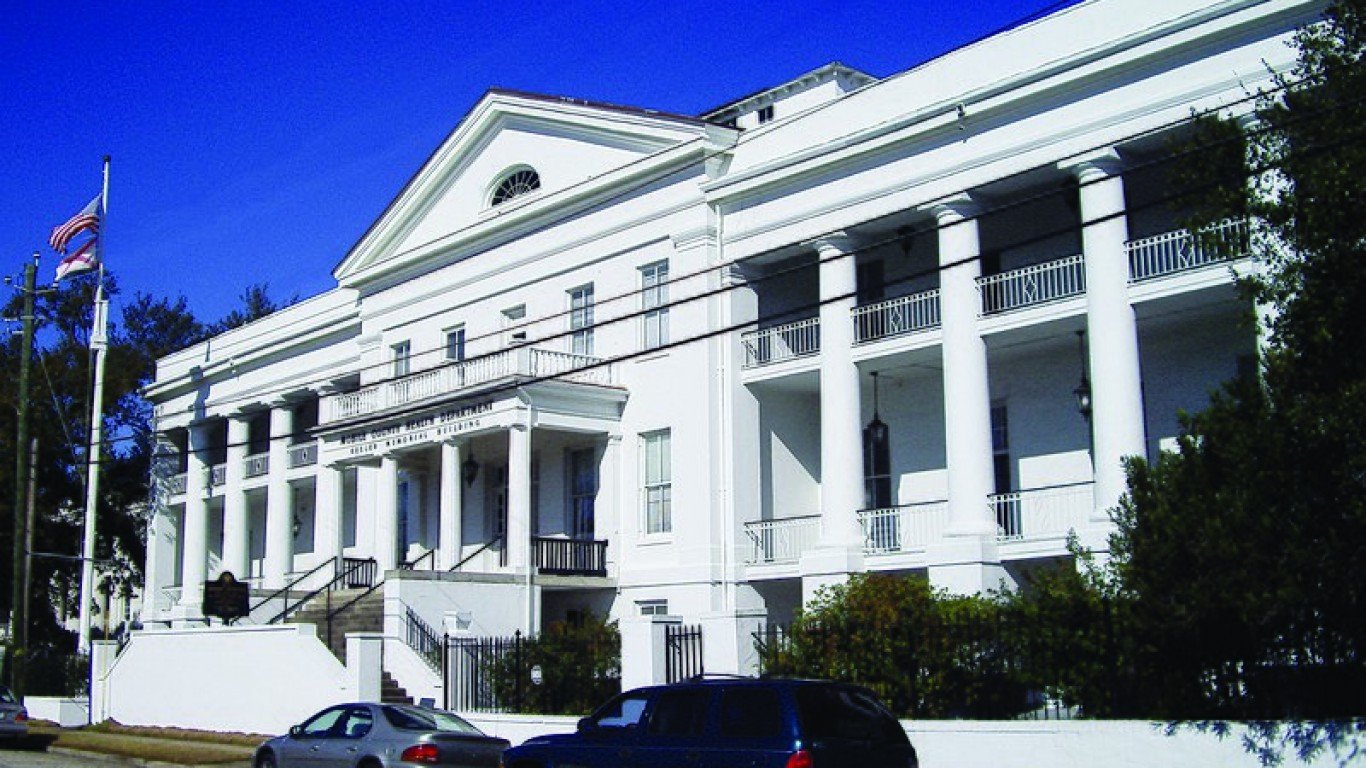
Source: Holdenquinn / Wikimedia Commons
Alabama: Ambulatory health care services
> Industry GDP contribution: $8.3 billion (4.6% of total)
> Industry workforce: 93,063 (4.9% of total)
> 5 yr. Industry GDP change: +14.6%
> Avg. industry salary: $61,356
Real estate is the largest industry in the vast majority of states. But after real estate, ambulatory health care services is the largest industry in Alabama by total economic output. The industry, which includes primary care physicians, dentists, and other outpatient medical services, generated $8.3 billion in Alabama in 2016, nearly 5% of the state’s total GDP. Older Americans typically require more medical care with greater frequency, so states that are home to older populations tend to have especially large ambulatory health care services sectors.. In Alabama, 16.1% of the population is 65 or older compared to 15.2% of the U.S. population as a whole.
[in-text-ad]
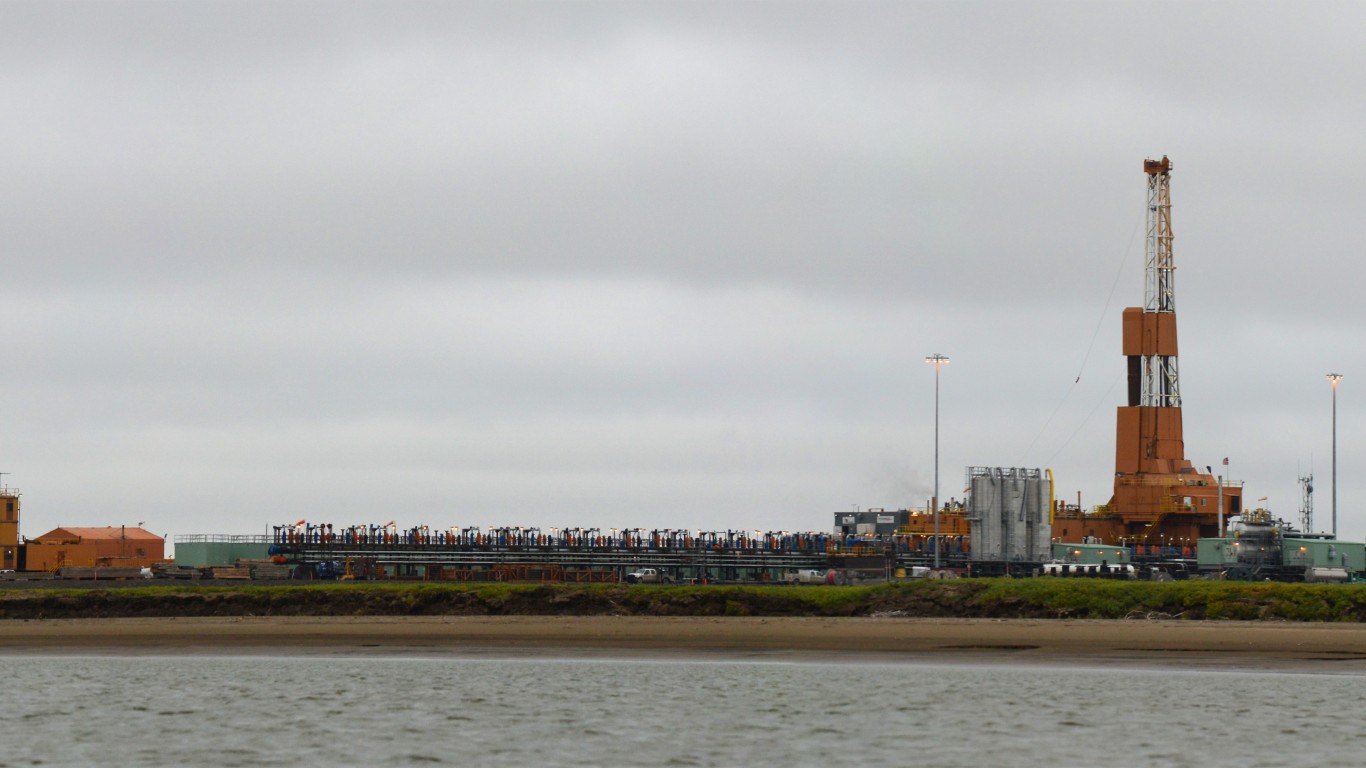
Source: Paxson Woelber / Wikimedia Commons
Alaska: Oil and gas extraction
> Industry GDP contribution: $7.4 billion (15.9% of total)
> Industry workforce: 3,777 (1.2% of total)
> 5 yr. Industry GDP change: -31.0%
> Avg. industry salary: $207,853
Alaska is a resource-rich state, with more proved oil reserves than all but three other states and some of the largest oil fields in the country. In recent years, the state’s heavy dependence on resource extraction has been a liability. The price of oil collapsed in 2014 and continued to fall through 2015 and into 2016, ultimately stymying economic growth in Alaska. From 2011 through 2016, economic output in Alaska’s oil and gas extraction industry dropped by 31.0%. Partially as a result, the state’s overall GDP fell by 8.0% over the same period, even as U.S. GDP climbed 10.5%.
Despite the decline in output, oil and gas extraction remains Alaska’s largest industry — even larger than real estate — with $7.4 billion, or 15.9% of Alaska’s total GDP in 2016.

Source: rexpartners / Getty Images
Arizona: Ambulatory health care services
> Industry GDP contribution: $12.9 billion (4.8% of total)
> Industry workforce: 151,405 (5.6% of total)
> 5 yr. Industry GDP change: +14.2%
> Avg. industry salary: $60,209
Ambulatory health care services accounts for nearly 5% of Arizona’s GDP, more than any other industry after real estate. Older Americans typically require more frequent health care, and like many other states with a larger than typical ambulatory health care services sector, Arizona is home to a relatively large retirement-age population. Nearly 17% of the state resident are 65 or older, a far greater share than the 15.2% of Americans nationwide.
The industry generated $12.9 billion in economic activity in 2016, up 14.2% from five years earlier. Over the same period, the state’s 65 and older population grew by 26.7%, more than in all but three other states.
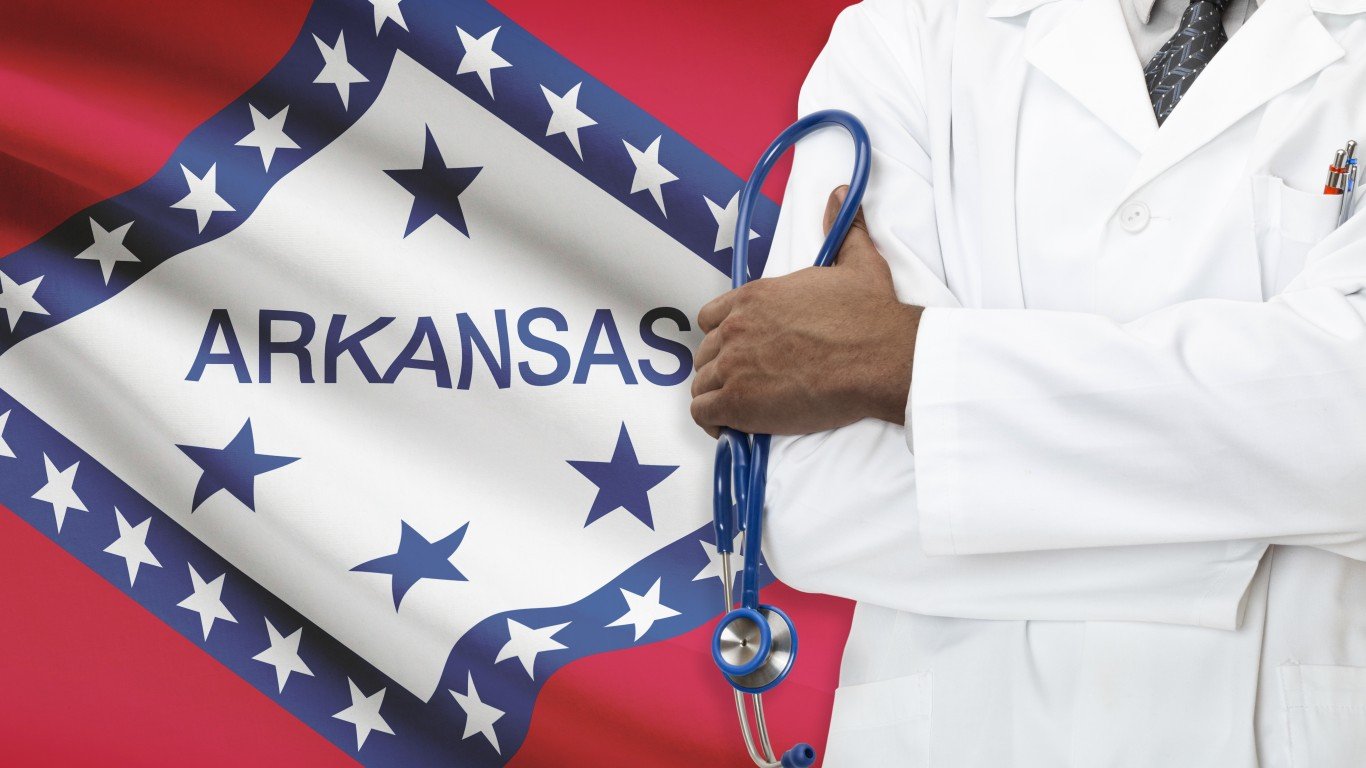
Source: Niyazz / Getty Images
Arkansas: Ambulatory health care services
> Industry GDP contribution: $4.6 billion (4.2% of total)
> Industry workforce: 53,943 (4.5% of total)
> 5 yr. Industry GDP change: +24.1%
> Avg. industry salary: $61,305
Americans with health insurance coverage are more likely to make regular doctor visits and receive preventative medical care. In Arkansas, one of 33 states to approve Medicaid expansion, just 7.9% of the population lacks health insurance, a smaller share than the 8.6% of the population nationwide. Likely due in part to better coverage and the increased likelihood of regular doctor visits, ambulatory health care services is the largest industry in Arkansas after real estate, accounting for 4.2% of the state’s GDP.
[in-text-ad-2]

Source: monkeybusinessimages / Getty Images
California: Computer and electronic product manufacturing
> Industry GDP contribution: $99.0 billion (4.3% of total)
> Industry workforce: 272,360 (1.6% of total)
> 5 yr. Industry GDP change: +50.1%
> Avg. industry salary: $160,915
Computer and electronic product manufacturing includes the production of semiconductors, navigational equipment, and communications equipment. The sector differs from other manufacturing subsectors as it involves highly specialized, miniaturized, technologically advanced components. The largest industry in California after real estate, computer and electronics manufacturing also is rapidly growing. The sector contributed $99.0 billion to the state’s economy in 2016, a more than 50% increase from half a decade prior.
Adjusting for exchange rates and inflation, California’s economic output recently surpassed that of the U.K., becoming the fifth largest economy in the world. The computer and electronics manufacturing industry accounted for 4.3% of the state’s GDP in 2016.
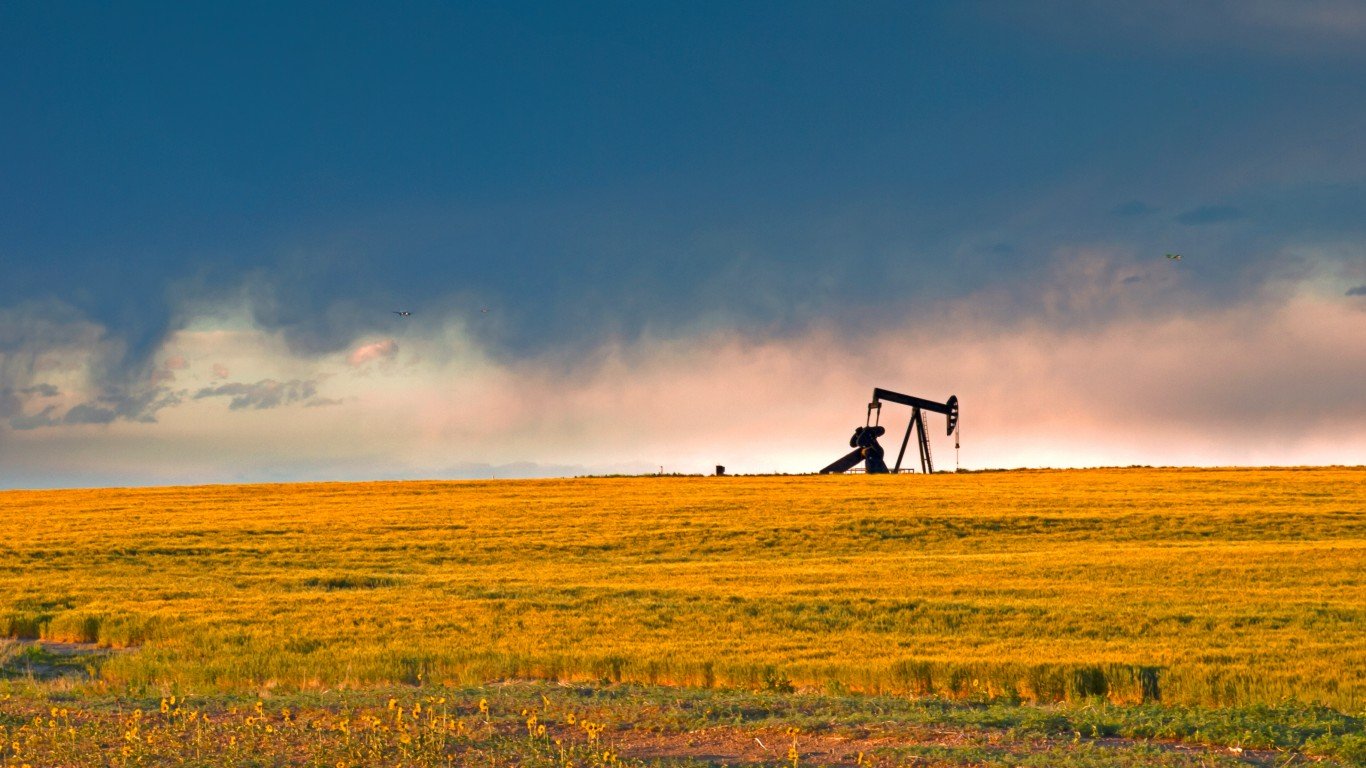
Source: arinahabich / Getty Images
Colorado: Oil and gas extraction
> Industry GDP contribution: $11.4 billion (3.9% of total)
> Industry workforce: 8,928 (0.3% of total)
> 5 yr. Industry GDP change: +72.7%
> Avg. industry salary: $166,397
Colorado’s oil and gas extraction industry accounts for about 4% of the state’s total GDP. Coincidentally, the state also is home to about 4% of proved crude oil reserves in the country and accounts for about 4% of U.S. oil production. From 2014 to 2016, the price of oil dropped by more than 50%, and Colorado’s oil and gas extraction industry was left damaged. The sector’s $11.4 billion in economic output in 2016 marked a nearly 10% decrease from the previous year.
Colorado’s economy managed to grow, despite the decline in its largest sector. Colorado’s GDP climbed 1.4% from 2015 to 2016, in line with the 1.5% U.S. GDP growth that year.
[in-text-ad]
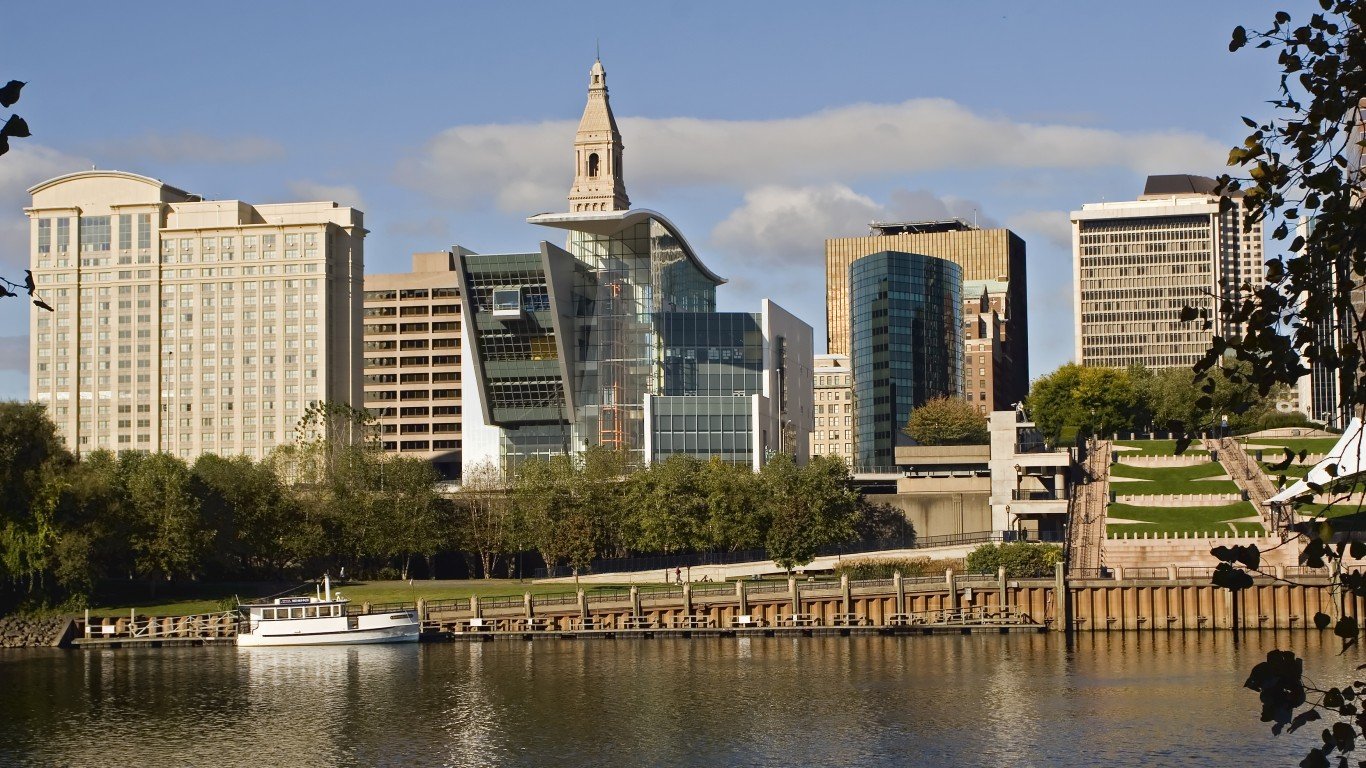
Source: vmnphoto / Getty Images
Connecticut: Insurance carriers and related activities
> Industry GDP contribution: $16.8 billion (7.4% of total)
> Industry workforce: 56,813 (3.4% of total)
> 5 yr. Industry GDP change: -7.4%
> Avg. industry salary: $127,679
In the last five years, Connecticut’s insurance sector’s economic output fell by 7.4%. Despite the decline, the industry remains dominant in the state. Insurance carriers and related activities generated $16.8 billion in economic activity in 2016, 7.4% of the state’s total GDP. Aetna, headquartered in Hartford, and the Bloomfield-based insurance giant Cigna each ranks among the 100 highest revenue companies in the United States. Due largely to the presence of Aetna, Hartford has long been known as the “Insurance Capital of the World.”
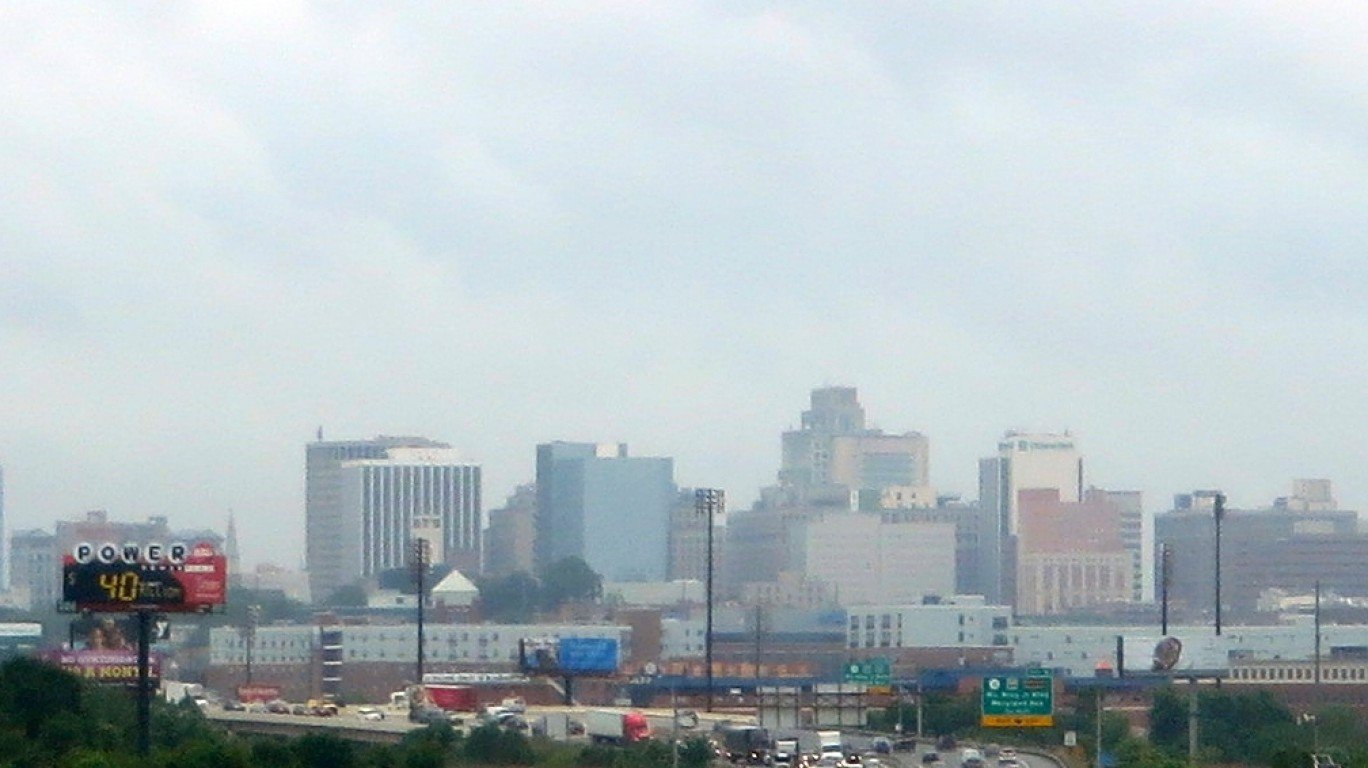
Source: kenlund / Flickr
Delaware: Insurance carriers and related activities
> Industry GDP contribution: $9.2 billion (15.1% of total)
> Industry workforce: 5,861 (1.3% of total)
> 5 yr. Industry GDP change: +35.9%
> Avg. industry salary: $80,924
Delaware’s economy relies more on the insurance sector than any other. Insurance carriers and related activities accounted for $9.2 billion in economic activity in Delaware in 2016, or 15.1% of total GDP. Salaries for those working in Delaware’s largest industry are generally high — nearly $81,000 on average a year. In comparison, the average annual salary across all wages in the state is $53,765.
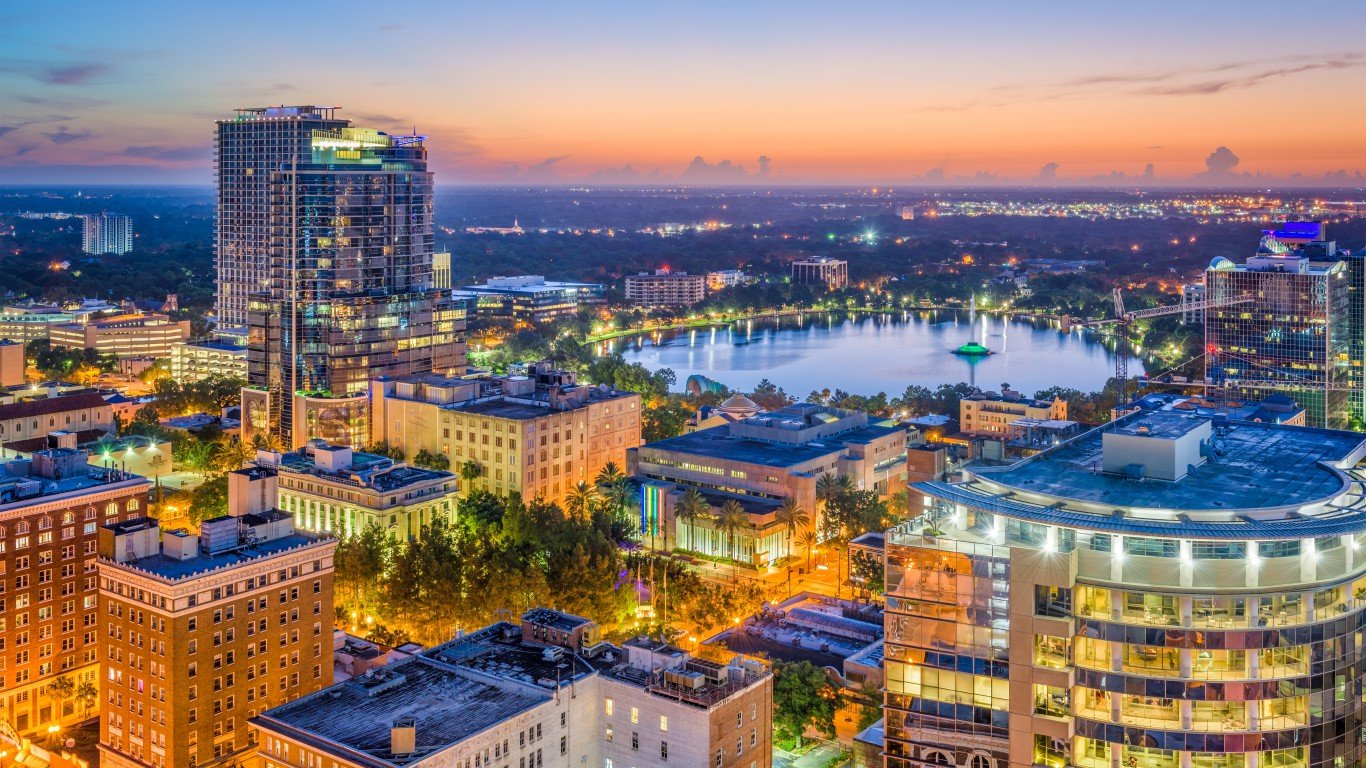
Source: Sean Pavone / Getty Images
Florida: Ambulatory health care services
> Industry GDP contribution: $40.2 billion (4.9% of total)
> Industry workforce: 471,900 (5.7% of total)
> 5 yr. Industry GDP change: +20.9%
> Avg. industry salary: $60,861
After real estate, ambulatory health care services is the largest industry in Florida, accounting for 4.9% of the state’s overall GDP. For comparison, ambulatory health care services accounts for 3.7% of national GDP.
Older Americans are more likely to need medical care and services more frequently, and Florida’s elderly comprise a larger share of its population than any other state. Nearly one in every five Florida residents are age 65 or older, well above the 15.2% of Americans nationwide. In the last half decade, the number of retirement-age residents in the state increased by 21.8%, faster than in most other states. Over the same period, economic activity in the state’s largest industry expanded by 20.1%.
[in-text-ad-2]

Source: J. Miers - User: (WT-shared) Jtesla16 at wts wikivoyage / Wikimedia Commons
Georgia: Broadcasting (except Internet) and telecommunications
> Industry GDP contribution: $30.5 billion (6.5% of total)
> Industry workforce: 57,493 (1.3% of total)
> 5 yr. Industry GDP change: +22.2%
> Avg. industry salary: $94,357
Georgia’s broadcasting and telecom industry generated $30.5 billion in 2016, or 6.5% of the state’s total GDP that year. In the last half decade, the industry’s economic output climbed by 22.2%. The surge in broadcasting, particularly of television shows, is due in part to the lucrative tax incentives that state lawmakers passed in 2007. As a result, film and television production spending in the state climbed from $93 million in 2007 to $2.7 billion in fiscal 2018. Currently, Georgia is the third largest television and film production and shooting location, trailing only California and New York.

Source: anyaberkut / Getty Images
Hawaii: Accommodation
> Industry GDP contribution: $3.9 billion (5.3% of total)
> Industry workforce: 40,225 (6.2% of total)
> 5 yr. Industry GDP change: +12.8%
> Avg. industry salary: $48,129
Hawaii logged a record 9.4 million visitors in 2017, the sixth consecutive record breaking tourism year for the state. Hawaii’s accommodation industry — which includes hotels, camps, and boarding houses — is a direct beneficiary of tourist spending. In the last five years, the industry’s economic output climbed 12.8%. In 2016, the sector generated $3.9 billion, or 5.3% of the state’s total GDP. For comparison, the accommodation sector accounts for just 0.8% of total national GDP.
[in-text-ad]

Source: ChrisBoswell / Getty Images
Idaho: Farms
> Industry GDP contribution: $2.9 billion (4.8% of total)
> Industry workforce: 18,986 (2.8% of total)
> 5 yr. Industry GDP change: +35.7%
> Avg. industry salary: $33,559
Farming is an economic pillar in Idaho, generating nearly $3 billion, or 4.8% of the state’s total GDP, in 2016. While the state is widely known for its potatoes — accounting for nearly a third of all U.S. potato production — it is also a major producer of a number of other crop and livestock products. Idaho is the largest producer of hard white wheat, a top producer of barley, and it accounts for 20% of all U.S. sugar beet production. Through its dairy farms — churning out over 13 billion pounds of milk a year — Idaho is the third largest cheese producer of any state. The state also is home to some of the nation’s largest cattle operations.
In the last five years, Idaho’s farming sector expanded by 35.7%, well above the industry’s 28.5% nationwide growth. Much of Idaho’s agricultural products are exported to Canada, Mexico, and parts of Asia. Foreign countries bought nearly $2 billion worth of crop and livestock products from Idaho farms in fiscal 2015 alone.

Source: 4u4me / Getty Images
Illinois: Insurance carriers and related activities
> Industry GDP contribution: $38.8 billion (5.6% of total)
> Industry workforce: 112,836 (1.9% of total)
> 5 yr. Industry GDP change: +69.5%
> Avg. industry salary: $89,913
The insurance industry is the largest in Illinois, accounting for 5.6% of the state’s 2016 GDP. Insurance giants Allstate, headquartered about 20 miles northwest of downtown Chicago, and State Farm, headquartered in Bloomington, each ranks among the 100 largest American companies by total revenue. In total, the industry generated $38.8 billion in Illinois in 2016, more than the entire economic output of both Vermont and Wyoming that year.
The U.S. insurance industry has grown rapidly in recent years, expanding by 46% in the last half decade. In Illinois, the industry has grown even faster, with its total economic output climbing 70% in the last five years.
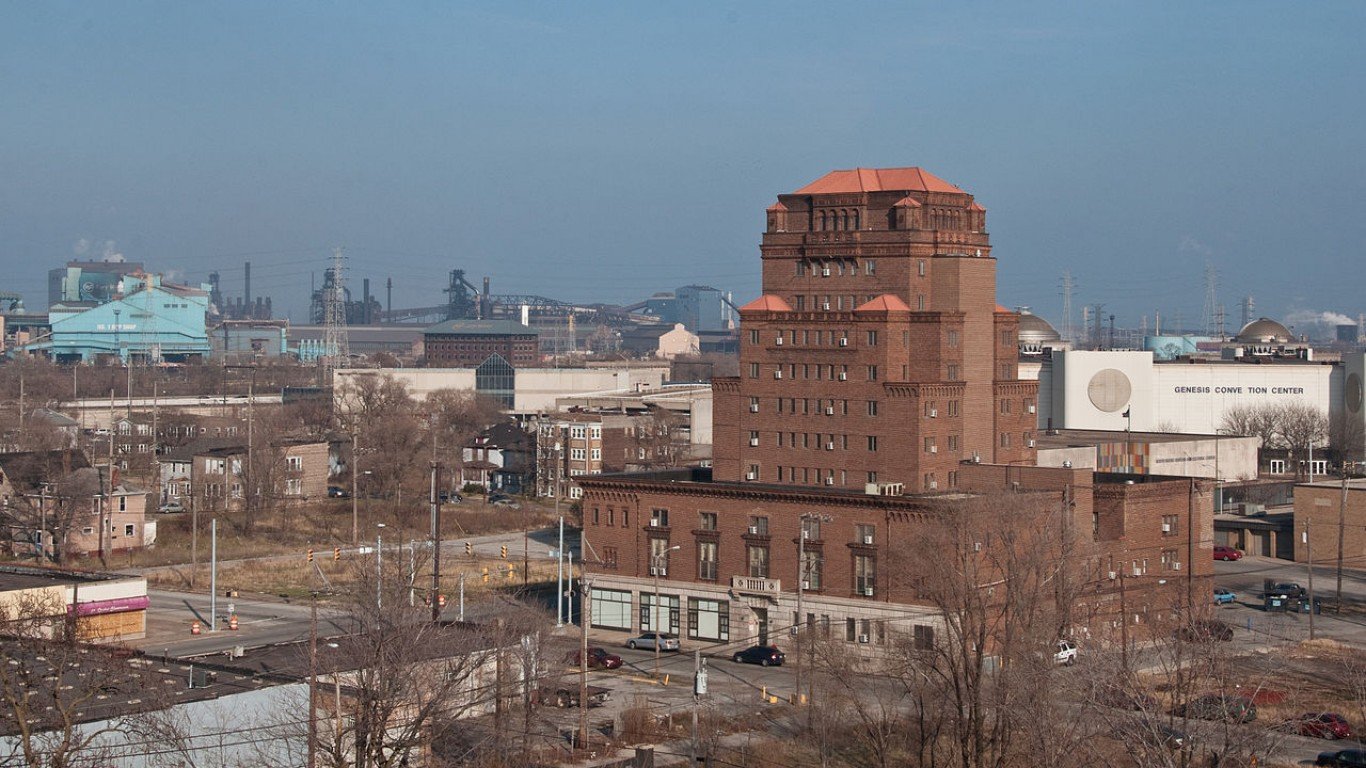
Source: Marc Tarlock from San Francisco / Wikimedia Commons
Indiana: Chemical manufacturing
> Industry GDP contribution: $19.8 billion (6.5% of total)
> Industry workforce: 30,239 (1.0% of total)
> 5 yr. Industry GDP change: -15.9%
> Avg. industry salary: $110,182
Chemical manufacturing generated $19.8 billion in Indiana in 2016, more than any other industry after real estate. The state is a hub for the broader manufacturing sector and is home to a number of companies in the chemical product manufacturing subsector, which includes makers of pharmaceuticals, cleaning products, and agrochemicals. Drug maker Eli Lilly, solvent maker Calumet, and plastics developer Berry Global are among the 10 largest companies headquartered in the state.
Economic output from the chemical manufacturing sector has been on a decline in the United States, contracting by 4.5% in the last half decade. In Indiana, the decline has been even more pronounced. Over the last half decade, Indiana’s chemical manufacturing sector has contracted by 15.9%.
[in-text-ad-2]
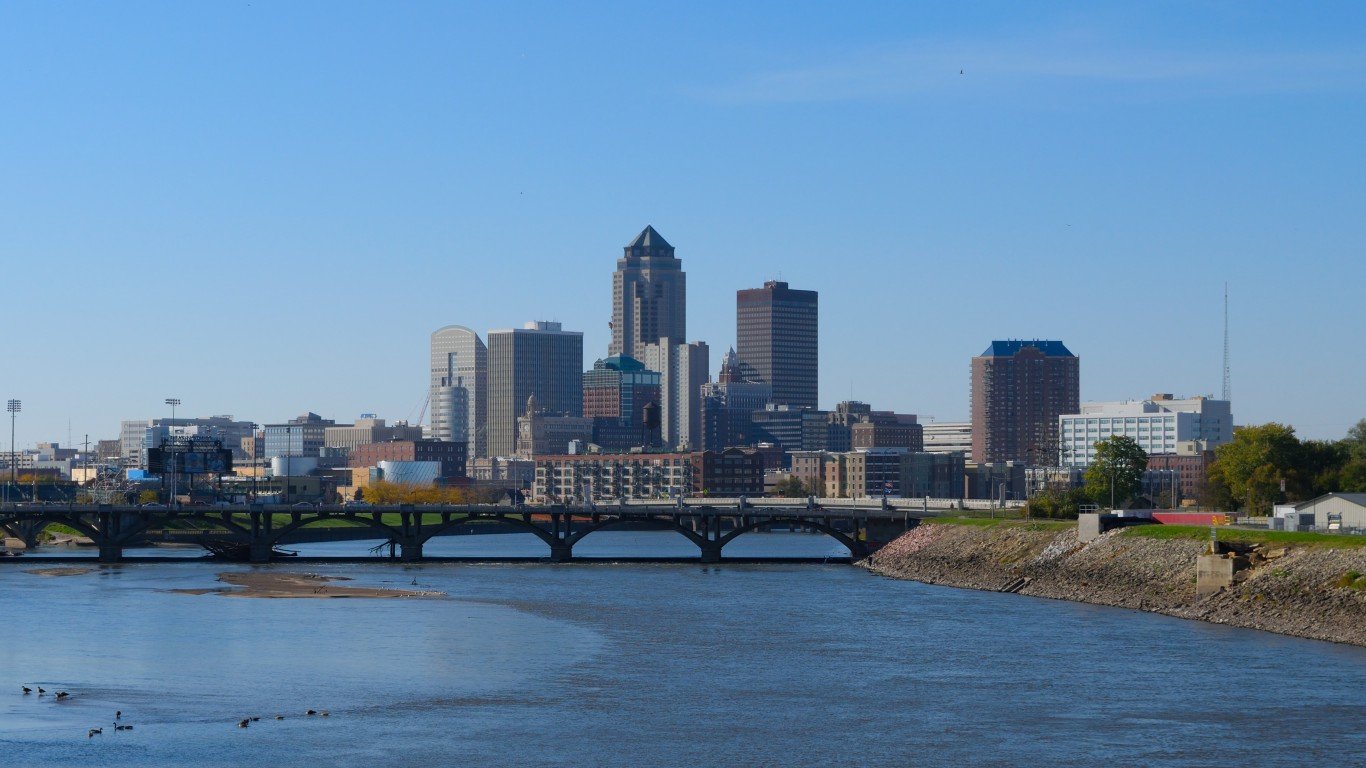
Source: MelindaRose / Getty Images
Iowa: Insurance carriers and related activities
> Industry GDP contribution: $20.2 billion (12.4% of total)
> Industry workforce: 44,236 (2.9% of total)
> 5 yr. Industry GDP change: +106.9%
> Avg. industry salary: $76,937
Iowa is one of just two states in which insurance is the largest economic driver, and one of nine if real estate is excluded from consideration. Insurance carriers and related activities generated $20.2 billion in 2016, 12.4% of Iowa’s overall GDP. Insurance giants ING and Nationwide have a strong presence in Des Moines, a city that is also home to the headquarters of the Fortune 500 insurance and investment management company, Principal Financial Group.
The U.S. insurance industry’s rapid growth in recent years has been an economic boon for Iowa. The economic output of the insurance sector has more than doubled in the last five years. Over the same period, the state’s GDP climbed 14.7%, well above the comparable 10.5% national GDP growth.

Source: ehrlif / Getty Images
Kansas: Farms
> Industry GDP contribution: $4.8 billion (3.5% of total)
> Industry workforce: 10,978 (0.8% of total)
> 5 yr. Industry GDP change: +12.3%
> Avg. industry salary: $38,857
Along with Idaho, Kansas is one of only two states in which farming is the largest industry after real estate. Over half of all sorghum for grain and more than a fifth of all wheat produced in the United States in 2016 came from Kansas. Kansas also exported more beef and veal than every state except Texas and Nebraska.
Both crop and livestock production generated a total of $4.8 billion, or 3.5%, of the state’s total GDP in 2016.
[in-text-ad]

Source: lovingav / Getty Images
Kentucky: Ambulatory health care services
> Industry GDP contribution: $7.1 billion (4.1% of total)
> Industry workforce: 83,484 (4.5% of total)
> 5 yr. Industry GDP change: +13.4%
> Avg. industry salary: $61,580
Americans with health insurance are more likely to receive necessary medical treatment and preventive care. And in Kentucky — one of 33 states to have adopted Medicaid expansion — just 5.1% of the population lacks health insurance coverage, a smaller share than in all but seven states. LIkely due in part to widespread coverage, outpatient medical services is a major industry in the state. Ambulatory health care services, including doctor’s offices and dentist’s offices, generated $7.1 billion in 2016 in the state, 4.1% of the state’s overall GDP.
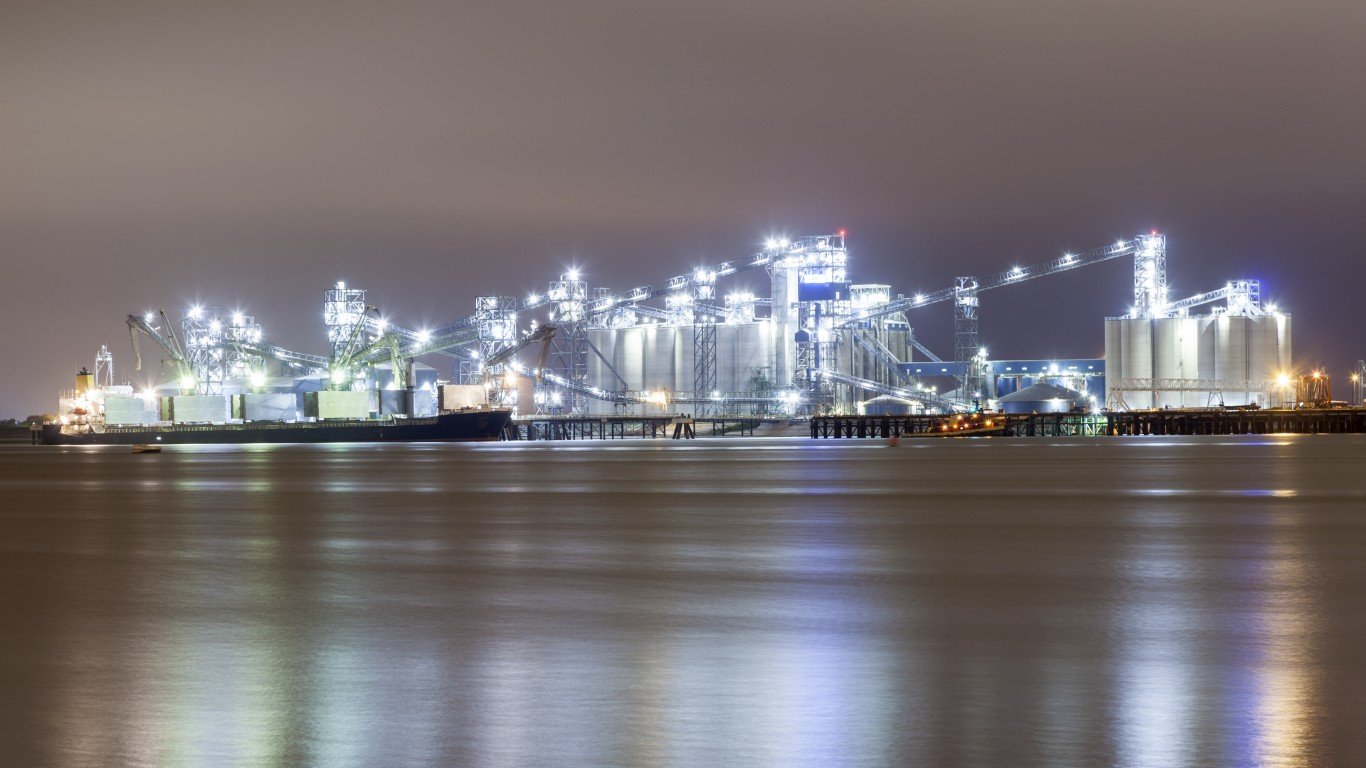
Source: typhoonski / Getty Images
Louisiana: Petroleum and coal products manufacturing
> Industry GDP contribution: $15.7 billion (7.5% of total)
> Industry workforce: 11,787 (0.6% of total)
> 5 yr. Industry GDP change: +41.5%
> Avg. industry salary: $123,292
After real estate, Louisiana is the only state where the petroleum and coal products manufacturing sector ranks as the largest sector. The industry generated $15.7 billion in 2016, or 7.5% of the state’s total GDP. For reference, petroleum and coal products manufacturing accounted for just 0.7% of total U.S. GDP in 2016. The state has 18 oil refineries that can process over 3.3 million barrels of crude oil a day and account for nearly 20% of total U.S. refining capacity. Much of the crude oil processed in the state is shipped from foreign countries to the Louisiana Offshore Oil Port — the first and only deepwater oil port in the country. Connected to over half of the U.S. refining capacity, the Louisiana Offshore Oil Port is the largest entry point for waterborne crude oil shipped to the United States.
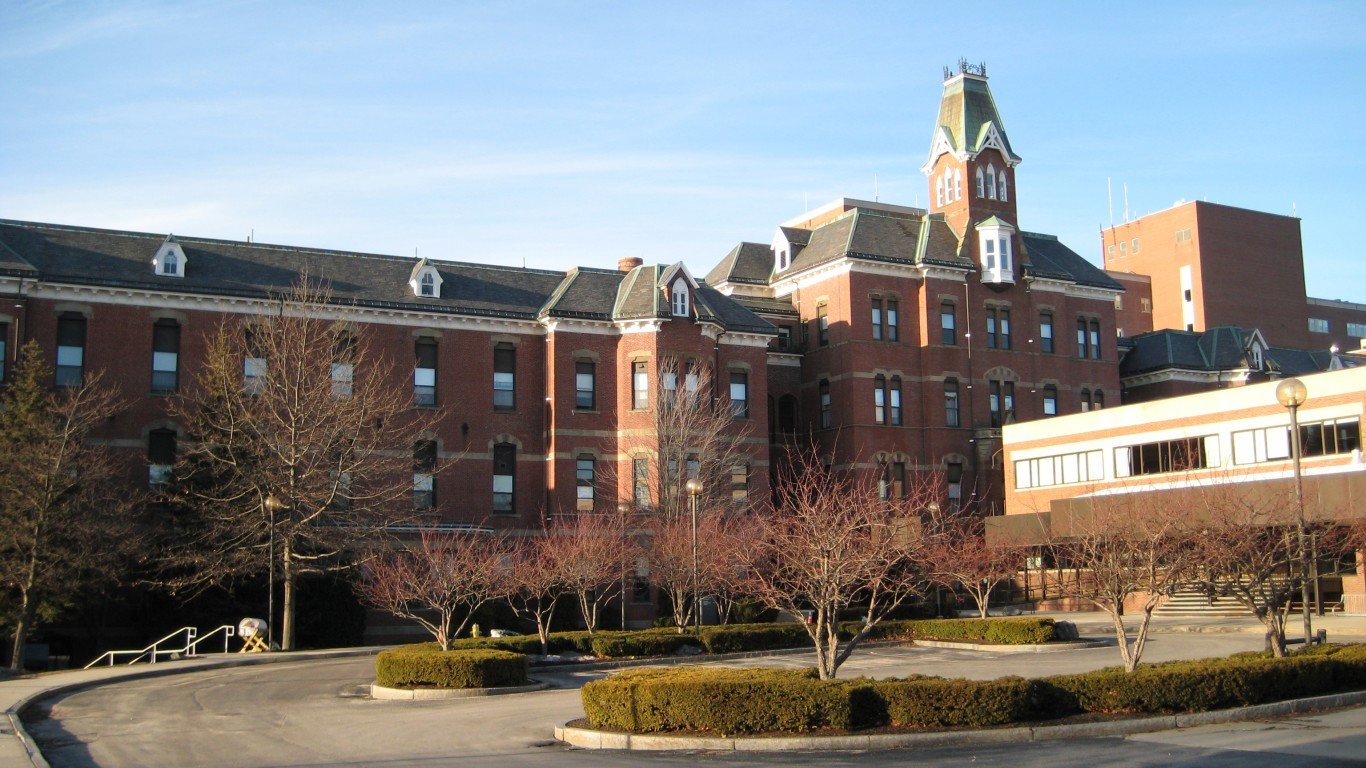
Source: User:Dudesleeper / Wikimedia Commons
Maine: Hospitals, nursing, and residential care facilities
> Industry GDP contribution: $3.2 billion (6.2% of total)
> Industry workforce: 56,069 (9.3% of total)
> 5 yr. Industry GDP change: -0.8%
> Avg. industry salary: $46,605
Hospitals, nursing, and residential care facilities — including nursing homes — is the largest sector in Maine after real estate. Generating $3.2 billion in 2016, the sector accounted for 6.2% of Maine’s total GDP.
The industry’s size is likely a practical necessity given the large share of elderly Americans who live in Maine. At 44.5 years, the median age in the state the highest in the country. Also, 19.3% of state residents are 65 or older, the largest share in the country after only Florida. Over the last half decade, the number of retirement age Maine residents increased by 18.1%, while the overall population climbed by just 0.2%.
[in-text-ad-2]

Source: SeanPavonePhoto / Getty Images
Maryland: Broadcasting (except Internet) and telecommunications
> Industry GDP contribution: $12.7 billion (3.8% of total)
> Industry workforce: 18,539 (0.7% of total)
> 5 yr. Industry GDP change: -3.9%
> Avg. industry salary: $92,335
Maryland is one of three states where broadcasting and telecommunications industry is the largest after real estate. The industry accounts for 3.8% of Maryland’s total GDP — slightly more than its 2.7% share of GDP on a national scale. The state is home to the headquarters of television broadcasting conglomerate Sinclair Broadcast Group. The company runs several radio stations and operates nearly 200 television stations in 89 markets nationwide.
While Maryland’s broadcasting and telecom industry’s economic output of $12.7 billion in 2016 was 10.1% higher than it was the previous year, its GDP contribution was 3.9% lower than it was half a decade ago.

Source: DenisTangneyJr / Getty Images
Massachusetts: Hospitals, nursing, and residential care facilities
> Industry GDP contribution: $19.8 billion (4.4% of total)
> Industry workforce: 298,095 (8.5% of total)
> 5 yr. Industry GDP change: +3.0%
> Avg. industry salary: $59,317
Hospitals, nursing, and residential care facilities is the largest industry in Massachusetts, generating $19.8 billion in 2016, 4.4%, of the state’s GDP.
There are several factors that partially explain the industry’s dominance. First, Americans with health insurance are more likely to seek necessary medical treatment, and just 2.5% of the state’s population lacks health insurance, the smallest share of any state. Additionally, Massachusetts is home to both Massachusetts General Hospital and Brigham and Women’s Hospital, each among that largest hospitals in the United States.
[in-text-ad]

Source: RiverNorthPhotography / Getty Images
Michigan: Hospitals, nursing, and residential care facilities
> Industry GDP contribution: $17.0 billion (4.0% of total)
> Industry workforce: 310,524 (7.3% of total)
> 5 yr. Industry GDP change: +3.7%
> Avg. industry salary: $48,059
The $17.0 billion generated by Michigan’s hospitals, nursing, and residential care facilities sector — which includes nursing homes — accounts for 4% of the state’s total GDP, more than any other industry after real estate.
The sector’s economic significance is partly attributable to the state’s relatively older population. Of the state’s 9.9 million residents, 16.2% are 65 or older, a larger share than the 15.2% of Americans nationwide. The state also is home to some of the largest hospitals in the country, including University of Michigan Hospitals and Health Centers in Ann Arbor and Butterworth Hospital in Grand Rapids.

Source: AndreyKrav / Getty Images
Minnesota: Ambulatory health care services
> Industry GDP contribution: $13.6 billion (4.5% of total)
> Industry workforce: 147,115 (5.2% of total) f/c
> 5 yr. Industry GDP change: +20.2%
> Avg. industry salary: $70,346
Ambulatory health care services industry — which includes doctors, dentists, and diagnostic labs — is the largest industry in Minnesota after real estate, generating $13.6 billion in 2016. Partially due to the world renowned Mayo Clinic medical center in Rochester, Minnesota, four of the 10 largest employers in the state are in health care. The size of the state’s outpatient medical services sector is also largely attributable to demand. Americans with health insurance are more likely to make regular doctor visits than those without insurance, and just 4.1% of Minnesota’s population is uninsured — less than half the 8.6% U.S. uninsured rate.

Source: nikkormat42 / Getty Images
Mississippi: Ambulatory health care services
> Industry GDP contribution: $4.1 billion (4.2% of total)
> Industry workforce: 47,882 (4.3% of total)
> 5 yr. Industry GDP change: +8.6%
> Avg. industry salary: $56,512
Mississippi’s largest industry after real estate is ambulatory health care services. The sector generated $4.1 billion in 2016, or 4.2% of the state’s total GDP. For reference, ambulatory health care services accounted for 3.7% of GDP nationwide.
The industry — which includes doctors, dentists, and diagnostic laboratories — is large despite the lower likelihood of state residents to make regular doctor visits. Americans with insurance visit the doctor with greater frequency, and in Mississippi, one of a minority of states not to pass Medicaid expansion, 11.8% of the population is uninsured, a larger uninsured rate than in all but five other states.
[in-text-ad-2]

Source: BCFDFF / Wikimedia Commons
Missouri: Hospitals, nursing, and residential care facilities
> Industry GDP contribution: $10.7 billion (4.1% of total)
> Industry workforce: 199,036 (7.2% of total)
> 5 yr. Industry GDP change: +2.9%
> Avg. industry salary: $44,443
Hospitals are a major economic engine in Missouri. The state is home to some of the largest hospitals in the country, including Barnes Jewish Hospital and Saint John’s Mercy Medical Center in St. Louis, as well as Saint John’s Hospital in Springfield. The need for nursing homes also likely boosts the industry’s economic contribution as 16.0% of the state’s population are 65 or older, compared to 15.2% of the U.S. population. All told, hospitals, nursing, and residential care facilities generated $10.7 billion in 2016, 4.1% of the state’s GDP. For comparison, nationwide, the industry accounted for 3.0% of U.S. GDP.

Source: Tbennert / Wikimedia Commons
Montana: Hospitals, nursing, and residential care facilities
> Industry GDP contribution: $2.0 billion (4.8% of total)
> Industry workforce: 36,683 (8.1% of total)
> 5 yr. Industry GDP change: +14.0%
> Avg. industry salary: $47,496
Montana is one of five states in which, after excluding real estate, hospitals, nursing, and residential care facilities is the largest industry. Like in the other states with the same largest industry, Montana’s population is older than that of the U.S. as a whole. The typical state resident is 40 years old compared to the 38 years median national age. Additionally, 17.6% of the population are age 65 or older, well above the comparable 15.2% share of Americans nationwide.
Montana’s elderly population is growing rapidly, likely driving the industry’s growth. In the last five years, the number of retirement age state residents climbed by 21.8%. Over the same period, the state’s largest industry grew by 14.0%.
[in-text-ad]
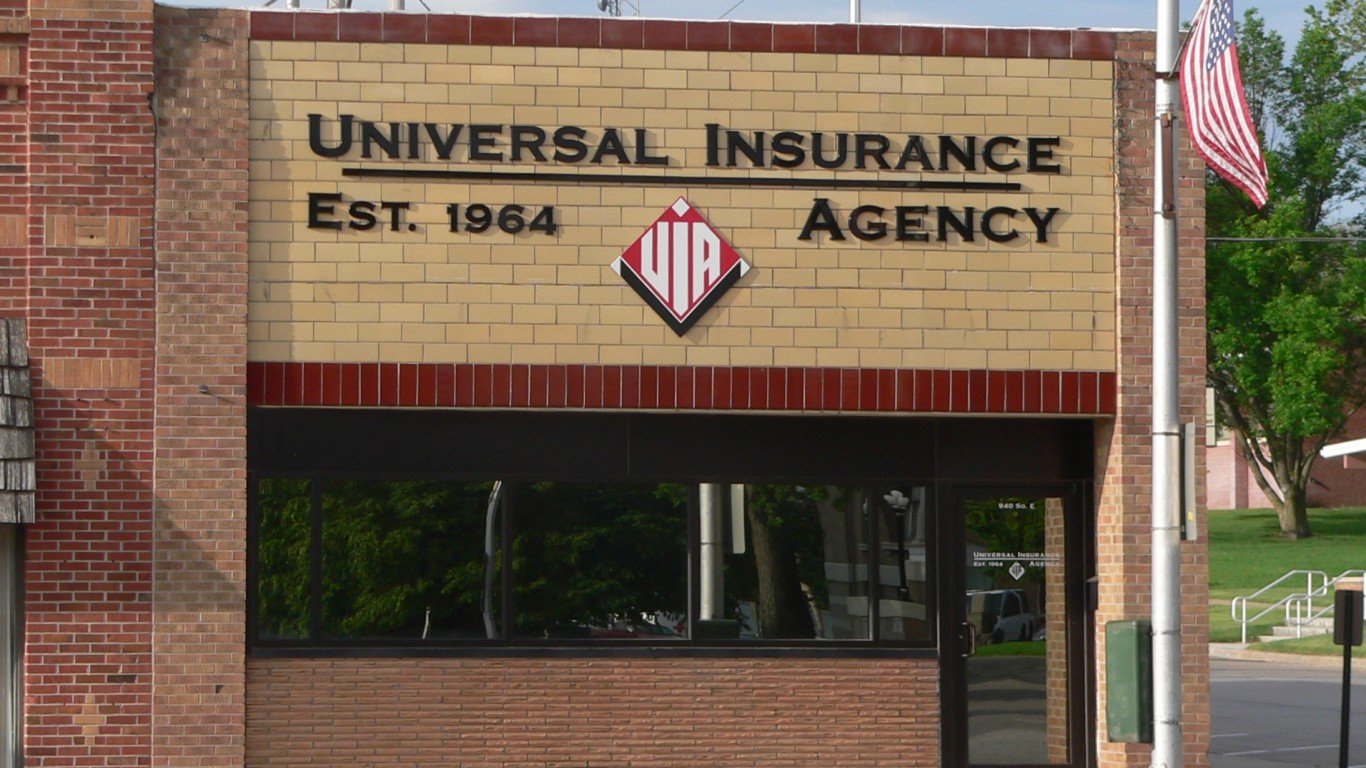
Source: Public Domain / Wikimedia Commons
Nebraska: Insurance carriers and related activities
> Industry GDP contribution: $8.3 billion (8.0% of total)
> Industry workforce: 25,775 (2.7% of total)
> 5 yr. Industry GDP change: +97.6%
> Avg. industry salary: $65,517
Nebraska’s insurance industry has more than doubled in size in the last five years and now ranks as the state’s largest industry, after real estate. Insurance and related activities generated $8.3 billion in 2016, 8.0% of the state’s total GDP. For reference, the insurance industry accounts for 3.2% of GDP on a national scale.
Notable companies in the industry headquartered in the state include Berkshire Hathaway and Mutual of Omaha — which rank third and 337 on the Fortune 500, respectively.

Source: f11photo / Getty Images
Nevada: Accommodation
> Industry GDP contribution: $13.6 billion (10.5% of total)
> Industry workforce: 192,296 (15.0% of total)
> 5 yr. Industry GDP change: -0.1%
> Avg. industry salary: $38,865
Tourism is an integral part of Nevada’s economy. More than 42.2 million people visited Las Vegas alone in 2017. Due in no small part to Sin City’s appeal, the accommodation industry, including hotels, RV camps, and boarding houses, generated $13.6 billion in 2016, slightly more than a 10th of the state’s total GDP. For reference, accomodation accounted for just 0.8% of GDP nationwide.
Tourism is also a boon for state and local coiffers. Statewide travel spending totalled $65.8 billion in 2016, generating $3.2 billion in tax revenue.

Source: kenlund / Flickr
New Hampshire: Insurance carriers and related activities
> Industry GDP contribution: $4.4 billion (6.3% of total)
> Industry workforce: 14,594 (2.3% of total)
> 5 yr. Industry GDP change: +82.2%
> Avg. industry salary: $87,766
The insurance industry accounts for 6.3% of New Hampshire’s GDP, nearly double the industry’s economic impact on a national scale. The industry has grown rapidly in recent years — and New Hampshire’s economy has benefited tremendously. Over the last half decade, the state’s insurance sector grew by 82.2%, contributing to the state’s 8.2% overall GDP growth.
For the nearly 15,000 New Hampshire residents working in the industry, wages are generally high. The average industry salary in the state is $87,766 a year, or $34,200 more than the average salary across all industries in the state.
[in-text-ad-2]

Source: SelectStock / Getty Images
New Jersey: Ambulatory health care services
> Industry GDP contribution: $21.1 billion (4.2% of total)
> Industry workforce: 226,697 (5.7% of total)
> 5 yr. Industry GDP change: +14.8%
> Avg. industry salary: $60,049
Though its economy is relatively diversified, New Jersey relies more heavily on ambulatory health care services than any other industry, not counting real estate. The sector, which includes doctors, dentists, and diagnostic labs, generated $21.1 billion in 2016, 4.2% of the state’s total GDP. In the last half decade, the industry expanded by nearly 15% — helping boost the state’s GDP growth to 5.5% over the same period.
New Jersey residents are more likely to make regular doctor visits than the typical American as the state’s uninsured rate of 8.0% is slightly below the comparable 8.6% U.S. rate.
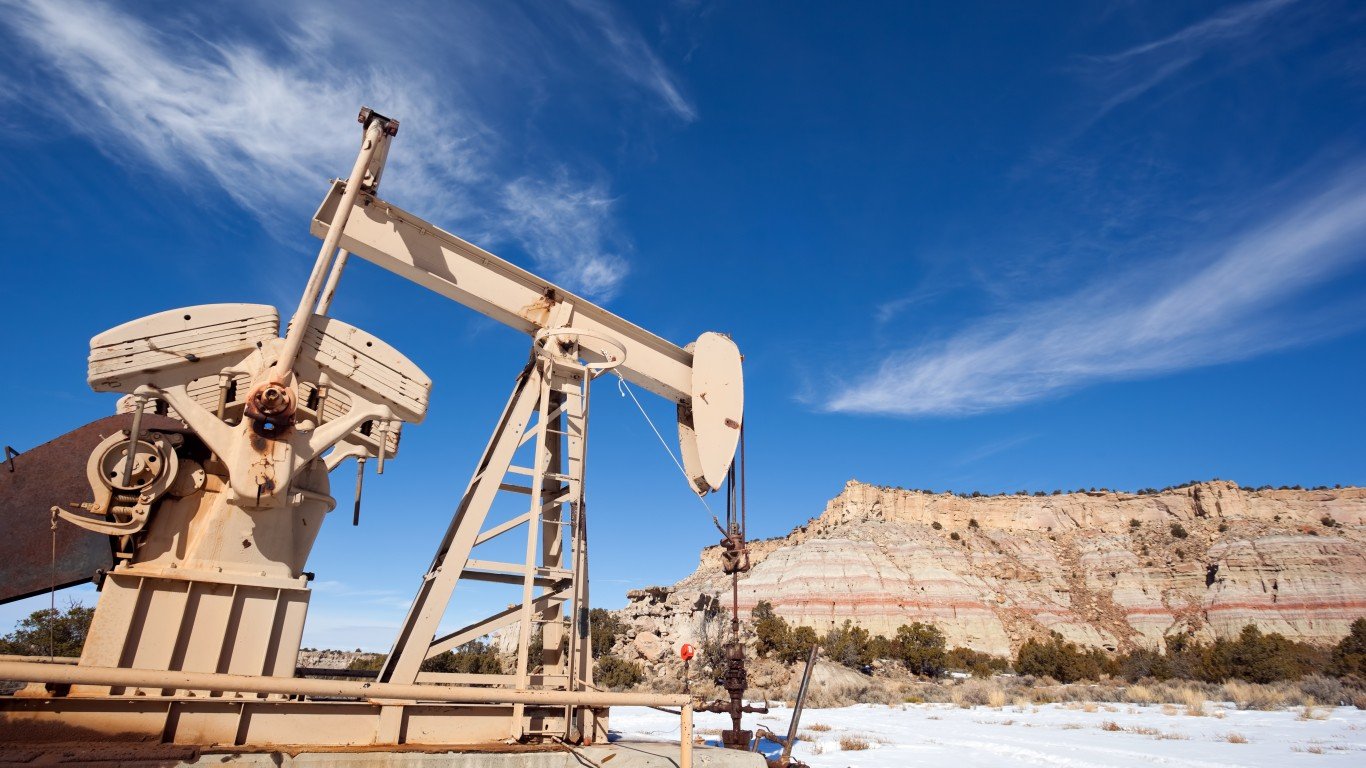
Source: amygdala_imagery / Getty Images
New Mexico: Oil and gas extraction
> Industry GDP contribution: $7.1 billion (8.2% of total)
> Industry workforce: 4,711 (0.6% of total)
> 5 yr. Industry GDP change: +47.7%
> Avg. industry salary: $104,394
New Mexico, home to two of the nation’s largest oil fields, is the sixth largest oil producing state, churning out about 500,000 barrels a day — more than double its 2009 production levels. The industry’s economic output totalled $7.1 billion in 2016, a 47.7% increase from five years prior.
Because oil and gas extraction is the New Mexico’s largest industry, the collapse in oil prices that lasted from 2014 through 2016 had broad economic implications for the state. The industry contracted by nearly 10% in the state from 2015 to 2016. Partially as a result, the state’s total GDP declined by 0.1% over the same period.
[in-text-ad]

Source: MBPROJEKT_Maciej_Bledowski / Getty Images
New York: Monetary authorities
> Industry GDP contribution: $76.5 billion (6.0% of total)
> Industry workforce: 163,004 (1.8% of total)
> 5 yr. Industry GDP change: -7.2%
> Avg. industry salary: $139,249
New York state’s banking sector — much of which is concentrated in Manhattan — generated $76.5 billion in 2016, more than the entire economies of over a dozen states, including Hawaii, Delaware, and North Dakota. New York, which is one of only three states with a GDP of over $1 trillion, has a relatively diverse economy. Even its largest industry accounts for just 6.0% of total economic output.
Jobs in New York’s finance sector tend to be high paying. The typical industry worker earns $139,149 a year, more than double the median annual salary of $67,940 across all industries in New York.

Source: AwakenedEye / Getty Images
North Carolina: Chemical manufacturing
> Industry GDP contribution: $22.4 billion (5.0% of total)
> Industry workforce: 41,278 (1.0% of total)
> 5 yr. Industry GDP change: -22.6%
> Avg. industry salary: $84,188
North Carolina’s chemical manufacturing sector has suffered in recent years. The industry’s economic output fell by 7.4% in the last year and by 22.6% in the last five. Still, it remains the largest industry in the state after real estate, generating $22.4 billion in 2016, or 5% of total state GDP. For reference, chemical manufacturing accounts for 1.8% of national GDP.
A number of major plastic, chemical, and pharmaceutical manufacturing companies have operations in the state, including BASF, Bayer, Merck, and Novartis.
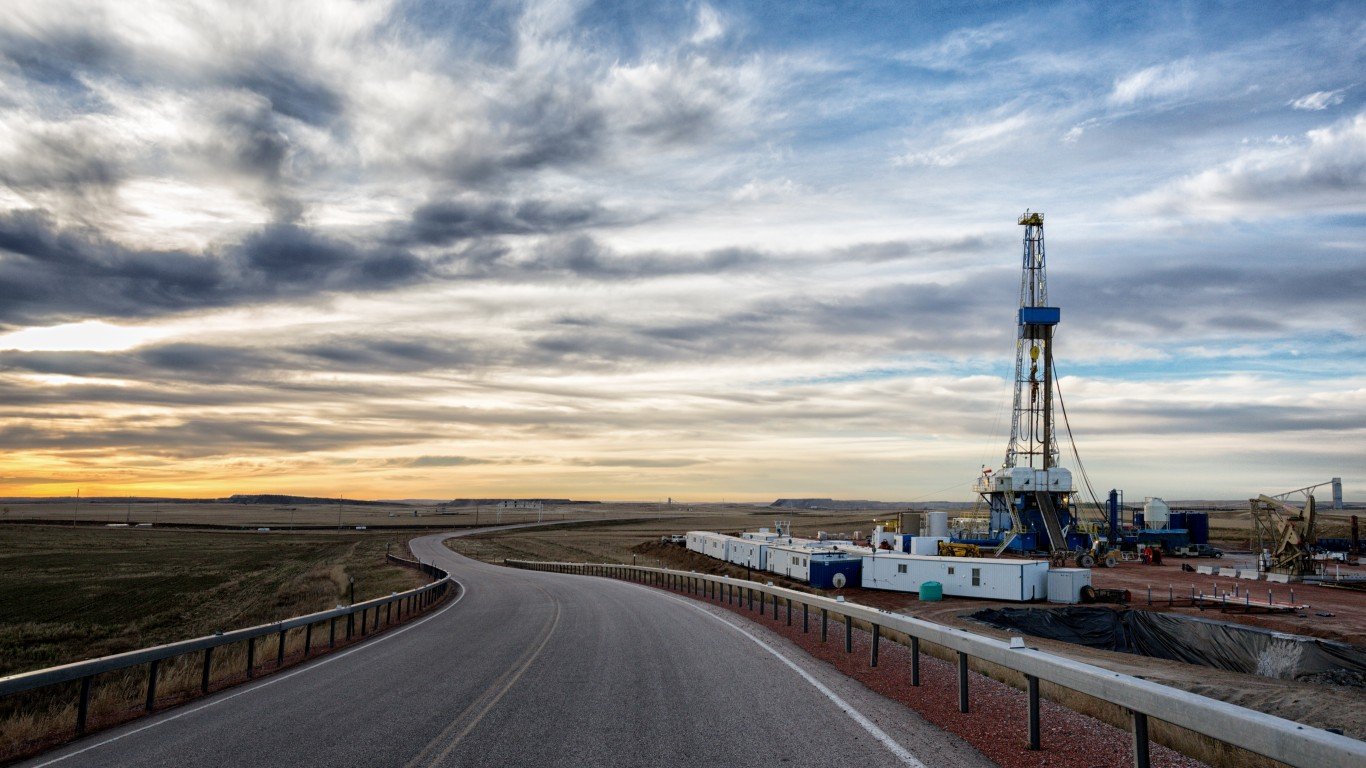
Source: grandriver / Getty Images
North Dakota: Oil and gas extraction
> Industry GDP contribution: $3.2 billion (6.6% of total)
> Industry workforce: 2,738 (0.7% of total)
> 5 yr. Industry GDP change: +154.5%
> Avg. industry salary: $120,405
Due to new horizontal drilling methods used in North Dakota’s Bakken shale formation, the region has fueled historic economic growth in the state. In the last five years, North Dakota’s oil and gas extraction industry has grown by over 150%. Over the same period, North Dakota’s total GDP shot up 24.1%, the strongest economic growth of any state and more than double the GDP growth of 10.5% nationwide.
Though North Dakota’s oil and gas extraction industry was slammed by falling oil prices from 2015 to 2016, falling 16.9% over that period, it remains the largest industry in the state, not counting real estate. Oil and gas extraction generated $3.2 billion in North Dakota in 2016, 6.6% of the state’s GDP.
[in-text-ad-2]

Source: RiverNorthPhotography / Getty Images
Ohio: Insurance carriers and related activities
> Industry GDP contribution: $26.4 billion (4.8% of total)
> Industry workforce: 107,248 (2.0% of total)
> 5 yr. Industry GDP change: +70.0%
> Avg. industry salary: $72,078
Ohio’s insurance industry experienced tremendous growth in recent years. Insurance and related activities generated $26.4 billion in the state in 2016, up 5.2% from 2016 and a 70% increase from five years prior. Not counting real estate, the insurance industry is the largest in Ohio, accounting for 4.8% of state GDP. For reference, insurance accounts for 3.2% of GDP on a national scale. Insurance giants Nationwide and Progressive are each based in the state.
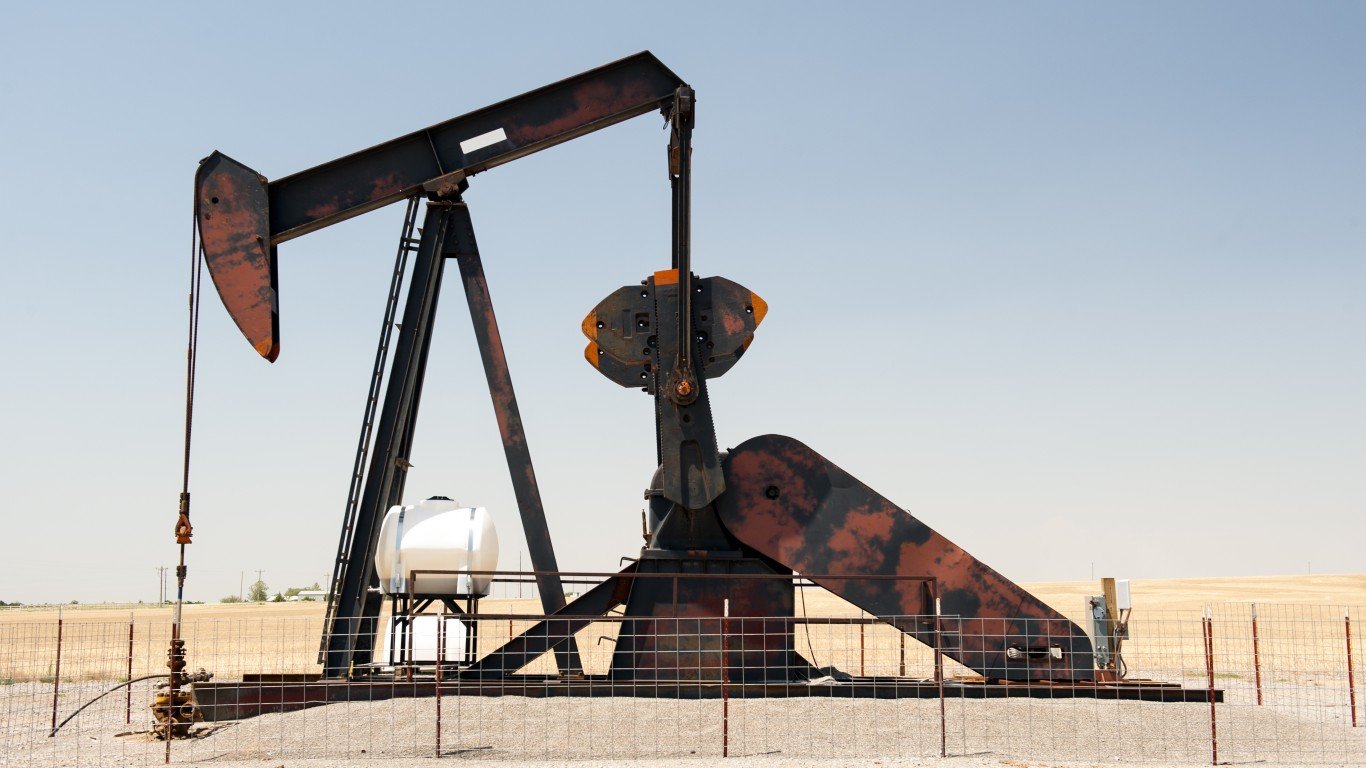
Source: Westhoff / Getty Images
Oklahoma: Oil and gas extraction
> Industry GDP contribution: $24.3 billion (14.0% of total)
> Industry workforce: 20,919 (1.3% of total)
> 5 yr. Industry GDP change: +75.6%
> Avg. industry salary: $125,702
Oklahoma is heavily dependent on its $23.4 billion oil and gas extraction industry. The largest industry in the state, oil and gas extraction accounts for 14.0% of Oklahoma’s GDP. In the majority of states, the largest industry (excluding real estate) accounts for less than 6% of total GDP.
Oil and gas extraction in Oklahoma has experienced something of a rebound in recent years. The state’s proved reserves more than doubled from 2007 to 2016, and crude oil production in 2016 was two and a half times what it was in 2005. In the last five years, the sector’s economic output spiked 75.6%, despite the sharp declines in oil prices from 2014 to 2016.
[in-text-ad]

Source: Image Source / Getty Images
Oregon: Computer and electronic product manufacturing
> Industry GDP contribution: $33.2 billion (16.0% of total)
> Industry workforce: 38,079 (2.1% of total)
> 5 yr. Industry GDP change: -36.1%
> Avg. industry salary: $131,658
In the vast majority of states, real estate is the largest industry based on contribution to state GDP. Oregon is a rare exception. There, computer and electronics manufacturing takes the top spot. The sector is a major economic driver, generating $33.2 billion in 2016, 16.0% of the state’s total GDP. Nationwide, the computer and electronic manufacturing industry accounts for 1.9% of GDP.
The Portland metro area alone is home to operations of such industry giants as IBM, Intel, and Xerox. The state is also home to notable private companies in the industry, including wireless technology company Rigado and computer and tablet maker Computer Technology Link.

Source: Public Domain / Wikimedia Commons
Pennsylvania: Broadcasting (except Internet) and telecommunications
> Industry GDP contribution: $40.0 billion (6.1% of total)
> Industry workforce: 35,224 (0.6% of total)
> 5 yr. Industry GDP change: +39.0%
> Avg. industry salary: $87,241
Along with Georgia and Maryland, Pennsylvania is one of three states where broadcasting and telecom is the largest industry after real estate. Expanding by 39% in the last five years, the industry generated $40.0 billion in 2016, or 6.1% of the state’s total economic output. Nationwide, the industry expanded by 23% in the last half decade and accounts for 2.7% of GDP.
Cable TV giant Comcast — which ranks 33rd on the Fortune 500 — is headquartered in Philadelphia

Source: cthulhuwho1 / Flickr
Rhode Island: Insurance carriers and related activities
> Industry GDP contribution: $2.9 billion (5.7% of total)
> Industry workforce: 9,070 (1.9% of total)
> 5 yr. Industry GDP change: +69.1%
> Avg. industry salary: $81,925
The insurance industry, which ranks as the largest industry in Rhode Island after real estate, has grown rapidly nationwide in recent years. In the last five years, the insurance sector’s economic output nationwide spiked 46.0%. In Rhode Island, the sector’s expansion was even more pronounced, climbing by 69.1% between 2011 and 2016. As of 2016, the insurance sector’s $2.9 billion in economic output accounted for 5.7% of Rhode Island’s GDP. Nationwide, the industry accounts for 3.2% of GDP.
Amica Mutual Insurance, headquartered in Lincoln, Rhode Island, is one of the largest employers in the state.
[in-text-ad-2]

Source: Sean Pavone / Getty Images
South Carolina: Ambulatory health care services
> Industry GDP contribution: $7.3 billion (4.0% of total)
> Industry workforce: 87,571 (4.4% of total)
> 5 yr. Industry GDP change: +26.3%
> Avg. industry salary: $58,934
Older Americans generally require more frequent medical treatment and preventive care. In South Carolina, 16.7% of residents are 65 or older, the 13th highest share among states. The elderly population partially drives the state’s ambulatory health care services sector, which generated $7.3 billion in economic output in 2016. And the number of retirement-age adults in South Carolina is growing rapidly — there were 26.8% more elderly residents in the state in 2016 than five years prior, a larger increase than in all but two other states.
South Carolina’s economy is relatively diverse, as its largest industry (after real estate) accounts for just 4.0% of its total GDP. The state is one of only six in which the largest industry after real estate accounts for 4.0% or less of total GDP.
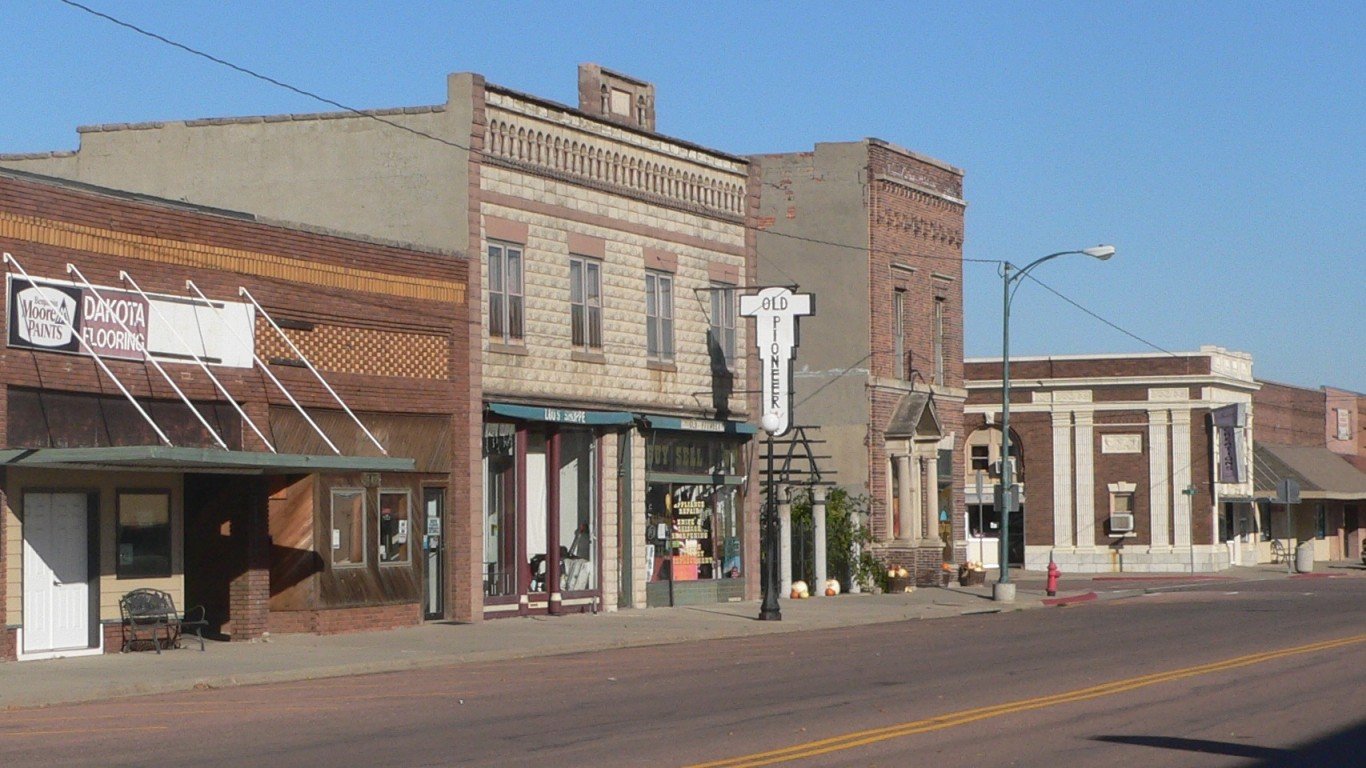
Source: Ammodramus / Wikimedia Commons
South Dakota: Monetary authorities
> Industry GDP contribution: $3.9 billion (9.4% of total)
> Industry workforce: 16,600 (3.9% of total)
> 5 yr. Industry GDP change: -21.0%
> Avg. industry salary: $56,682
After real estate, banking is the largest sector in South Dakota, accounting for 9.4% of the state’s GDP. For reference, banking accounts for just 2.1% of U.S. GDP.
The state’s large banking industry can be traced back to the economic recession of the early 1980s. In an attempt to attract new business, state lawmakers eliminated regulatory caps on interest rates and fees for banks. Citibank was the first major financial institution to take advantage, and has since brought thousands of jobs to Sioux Falls. Citibank was soon joined by other institutions, including Wells Fargo, Capital One, and First Premier. As recently as half a decade ago, South Dakota had about $2.5 billion in bank assets, the most of any state.
[in-text-ad]

Source: GreenStock / Getty Images
Tennessee: Ambulatory health care services
> Industry GDP contribution: $14.5 billion (5.0% of total)
> Industry workforce: 146,654 (5.1% of total)
> 5 yr. Industry GDP change: +19.1%
> Avg. industry salary: $62,007
The ambulatory health care services industry — which includes doctors, dentists, and diagnostic labs — is the largest industry in Tennessee after real estate. The sector employs 5.0% of workers in the state and generated $14.5 billion in 2016, 5.0% of the state’s GDP.
Americans with health insurance are more likely to receive necessary medical treatment, preventive care, and visit the doctor. In Tennessee, a larger than typical 9.0% of the population is uninsured — partly because it is one of a minority of states to not pass Medicaid expansion under the Affordable Care Act. Greater insurance coverage would likely help spur growth in the state’s largest industry.
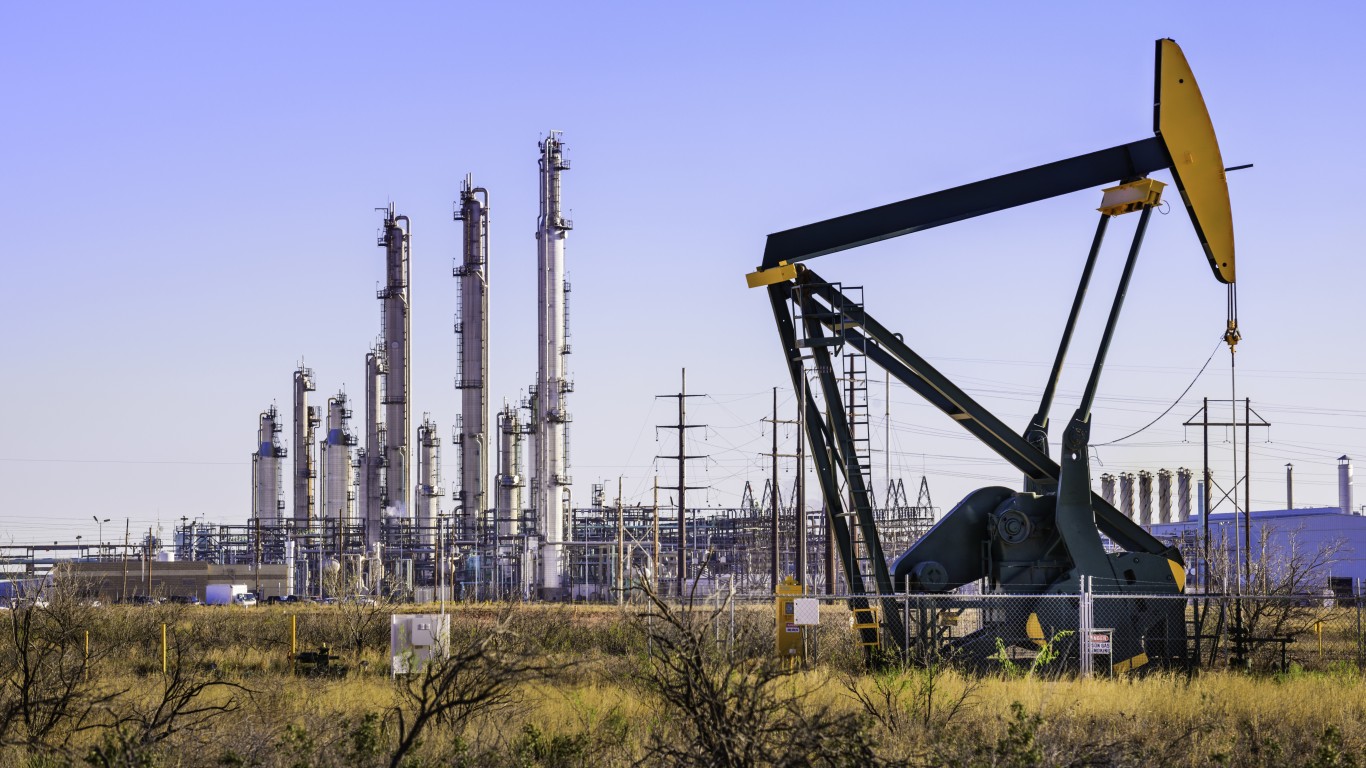
Source: dszc / Getty Images
Texas: Oil and gas extraction
> Industry GDP contribution: $137.2 billion (9.3% of total)
> Industry workforce: 93,333 (0.8% of total)
> 5 yr. Industry GDP change: +57.2%
> Avg. industry salary: $184,952
Texas is home to over a third of all proved oil reserves in the United States and more than 25 of the country’s 100 largest oil fields. The largest industry in the state, oil and gas extraction, generated $137.2 billion in 2016, more than the entire GDP of Montana, South Dakota, Vermont, and Wyoming combined. The industry accounts for 9.3% of the state’s economy. In the majority of states, the largest industry (excluding real estate) accounts for less than 6% of economic output.
Heavily dependent on oil and gas extraction, Texas’s economy suffers when its largest industry struggles. The price of oil fell precipitously from 2014 through 2016, resulting in a 15.7% economic decline the state’s oil extraction sector from 2015 to 2016. Over the same period, Texas’s overall GDP dipped by 0.4%.
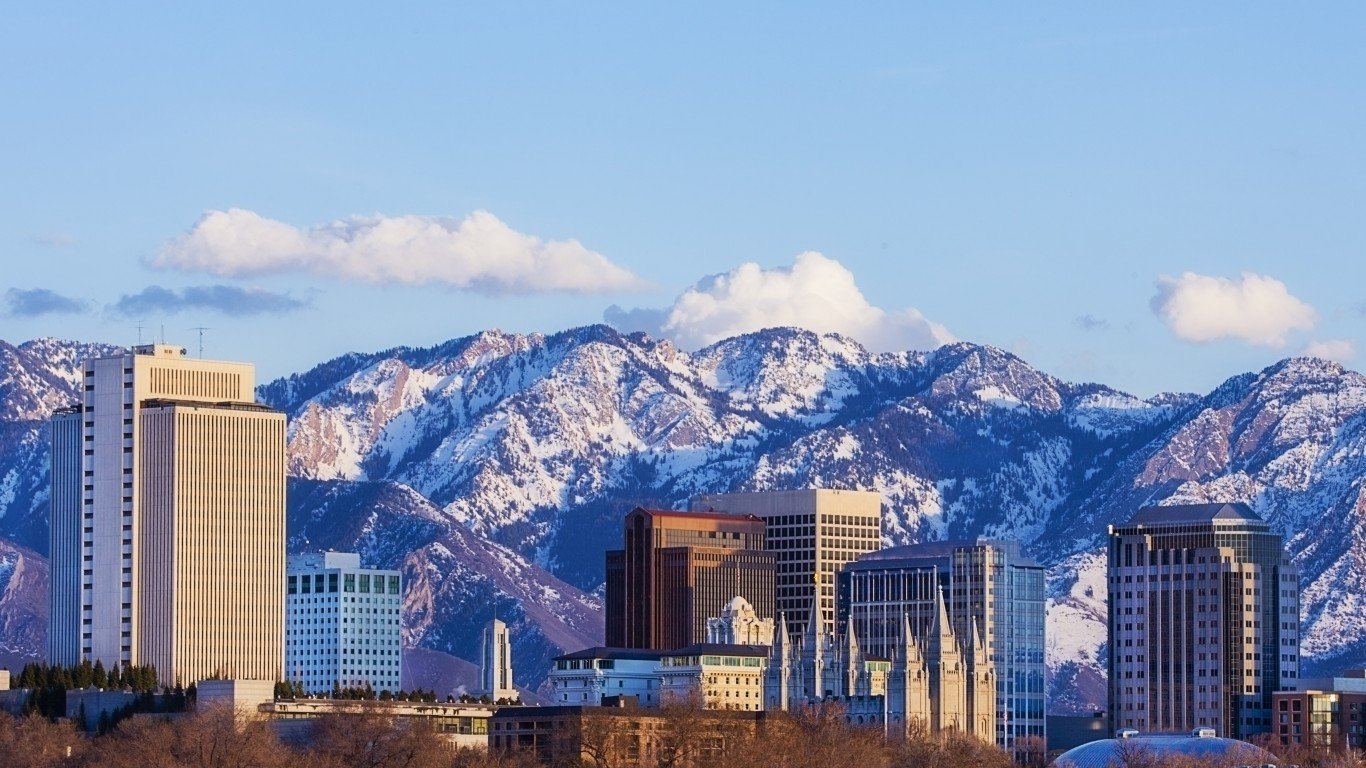
Source: strickke / Getty Images
Utah: Monetary authorities
> Industry GDP contribution: $5.8 billion (4.2% of total)
> Industry workforce: 35,942 (2.6% of total)
> 5 yr. Industry GDP change: +1.4%
> Avg. industry salary: $63,586
Utah is one of only a handful of states where companies are legally allowed to set up industrial banks. These banks exist to make loans to businesses with fewer restrictions than commercial banks, and such institutions can be owned and operated by non-financial companies. Now home to 15 active industrial banks, including one in Salt Lake City owned by BMW, the state has become an industrial banking hub in the last two decades. Utah’s position as a national leader in industrial banking was solidified after congress prohibited industrial banks in states in which they did not already exist.
Partially as a result, banking is the largest industry in Utah after real estate, generating $5.8 billion in 2017, 4.2% of the state’s total economic output.
[in-text-ad-2]

Source: Yellowdog Productions / Getty Images
Vermont: Ambulatory health care services
> Industry GDP contribution: $1.3 billion (4.9% of total)
> Industry workforce: 17,031 (5.5% of total)
> 5 yr. Industry GDP change: +16.7%
> Avg. industry salary: $54,432
Ambulatory health care services is Vermont’s largest industry after real estate partially because of widespread health insurance coverage among residents and the age of the population. Americans with health insurance are more likely to make regular doctor visits, and just 3.7% of Vermonters are uninsured, the third smallest share of any state and less than half the 8.6% national uninsured rate. Additionally, elderly Americans are more likely to make regular visits to the doctor, and Vermont’s median age is 43.1 years, making it the second oldest state in the country. Similarly, 18.2% of the state’s population are 65 or older, a larger share than all but three other states.
Ambulatory health care services generated $1.3 billion in Vermont in 2016, nearly 5% of the state’s GDP.

Source: ablokhin / Getty Images
Virginia: Ambulatory health care services
> Industry GDP contribution: $15.3 billion (3.5% of total)
> Industry workforce: 172,286 (4.5% of total)
> 5 yr. Industry GDP change: +19.7%
> Avg. industry salary: $62,168
Ambulatory health care services is the largest private sector industry in Virginia after real estate. The industry, which includes doctors, dentists, and diagnostic labs, generated $15.3 billion in 2016. While outpatient health care services is the largest industry in the state, it not as dominant as oil extraction is in Texas or computer manufacturing is in Oregon. Virginia’s economy is heavily diversified, and ambulatory health care accounts for just 3.5% of total GDP, making the state one of only six where no industry accounts for more than 4% of GDP.
[in-text-ad]

Source: zodebala / Getty Images
Washington: Publishing industries (except Internet)
> Industry GDP contribution: $33.7 billion (8.0% of total)
> Industry workforce: 64,452 (2.0% of total)
> 5 yr. Industry GDP change: +31.9%
> Avg. industry salary: $196,498
Publishing — which includes traditional print as well as software publishing — is the largest industry in Washington. The state is the home of Microsoft, which alone employs over 46,000 state residents — over one-third of the company’s global workforce. The software giant is one of the largest companies in the United States, ranking 30th on the Fortune 500.
Due in no small part to Microsoft, Washington’s publishing industry generated $33.7 billion in 2016, 8.0% of its GDP. For reference, publishing accounts for just 1.4% of total U.S. GDP.
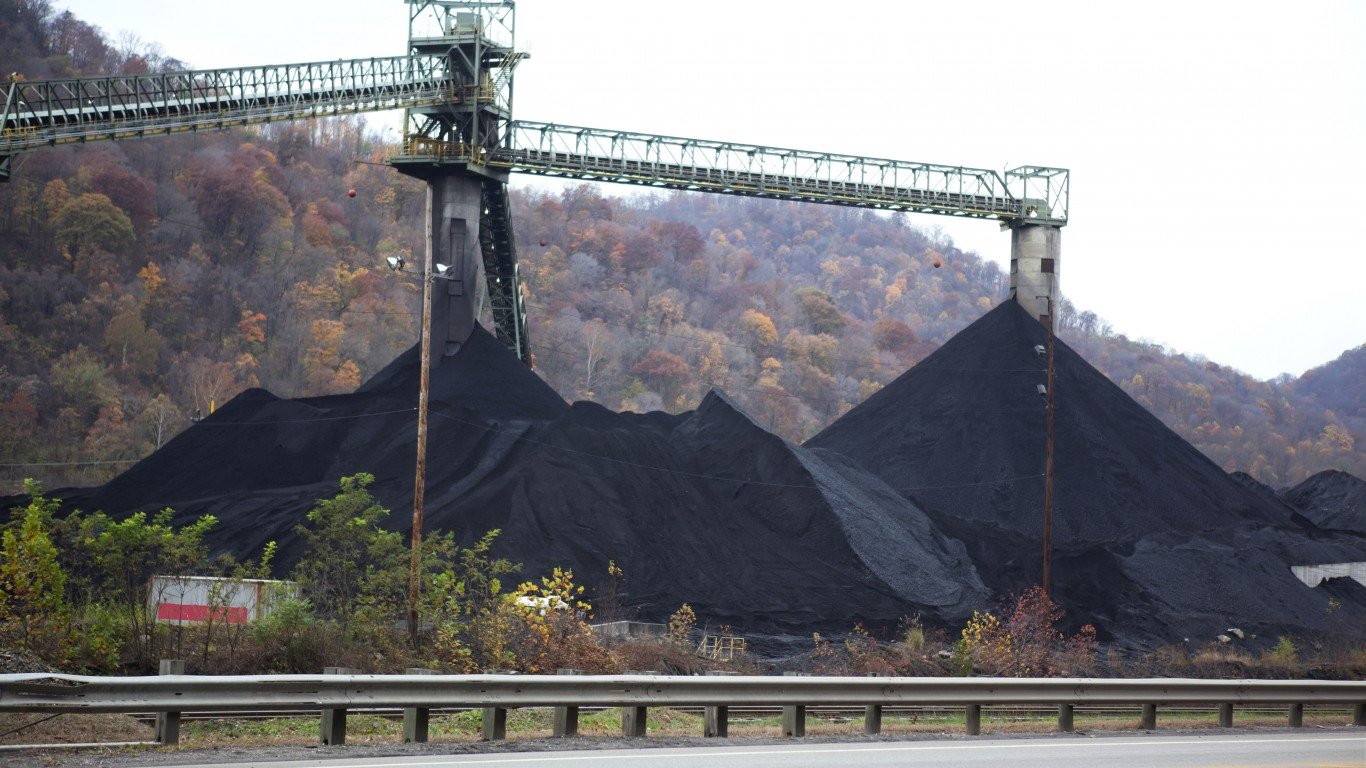
Source: JodiJacobson / Getty Images
West Virginia: Mining (except oil and gas)
> Industry GDP contribution: $4.6 billion (6.9% of total)
> Industry workforce: 12,566 (1.8% of total)
> 5 yr. Industry GDP change: -43.4%
> Avg. industry salary: $77,352
Coal mining has been an integral part of West Virginia’s economy for over a century, with large-scale mining operations beginning in the mid 1800’s. With coal deposits in 53 of the state’s 55 counties, West Virginia ranks as the second largest coal producer in the country, trailing only Wyoming. Mining generated $4.6 billion in West Virginia in 2016, nearly 7% of the state’s GDP.
Clean energy initiatives have had a considerable impact on coal-mining economies in recent years. Over the last half decade, mining’s economic output fell 43.4% in West Virginia. Such a considerable decline in the state’s largest industry had broader economic implications, as over the same period, West Virginia’s GDP dipped by 1.2%.

Source: driftlessstudio / Getty Images
Wisconsin: Insurance carriers and related activities
> Industry GDP contribution: $18.1 billion (6.5% of total)
> Industry workforce: 63,219 (2.2% of total)
> 5 yr. Industry GDP change: +60.5%
> Avg. industry salary: $71,077
Wisconsin is one of nine states in which insurance is the largest industry, not counting real estate. The state is home to the corporate headquarters of some industry giants, including Northwestern Mutual Life Insurance, which is based in Milwaukee, and American Family Insurance Group in Madison. All told, insurance and related activities generated $18.1 billion in Wisconsin in 2016, 6.5% of the state’s total GDP.
The industry has been an economic boon for the state in recent years, growing by 60.5% in Wisconsin in the last half decade. Over the same period, the state’s GDP increased 8.2%.
[in-text-ad-2]
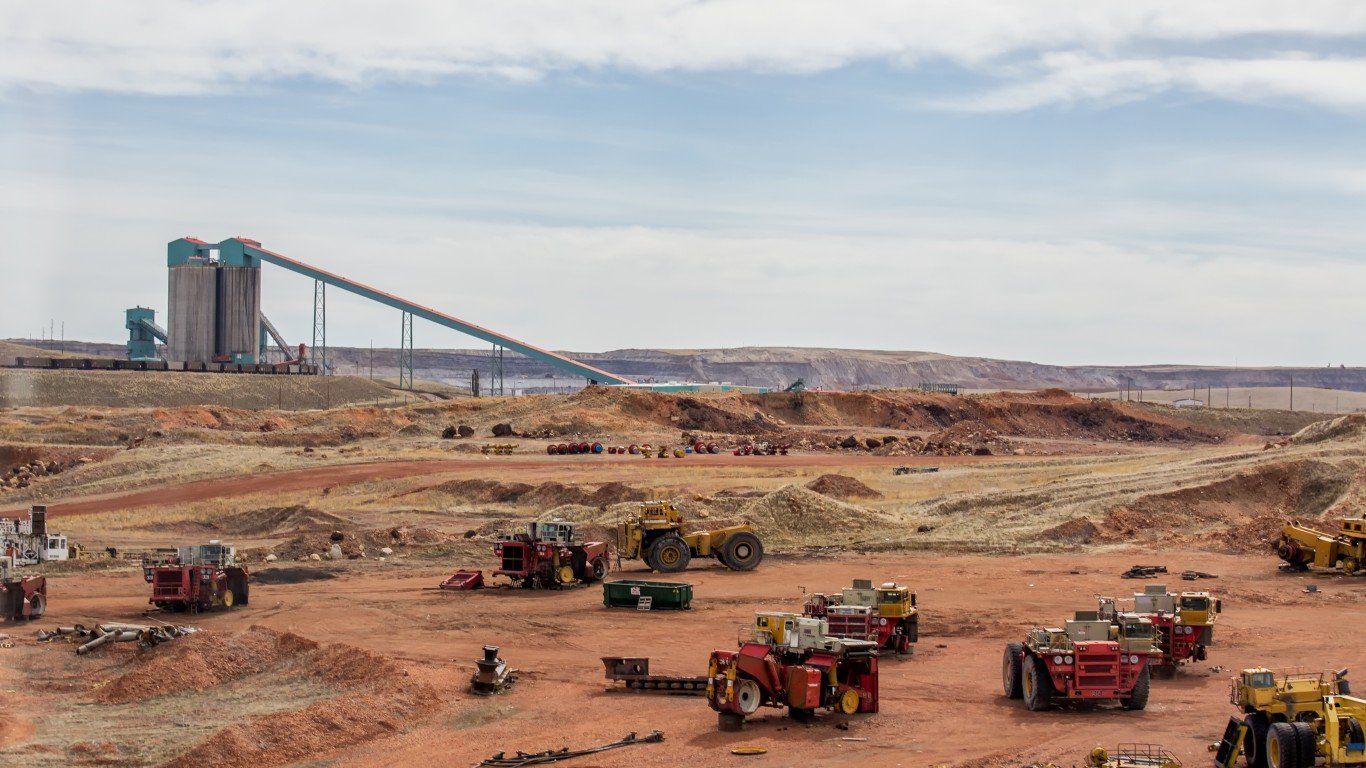
Source: Kat72 / Getty Images
Wyoming: Mining (except oil and gas)
> Industry GDP contribution: $4.4 billion (12.7% of total)
> Industry workforce: 8,492 (3.1% of total)
> 5 yr. Industry GDP change: -18.5%
> Avg. industry salary: $86,482
Home to over a third of recoverable U.S. coal reserves, Wyoming has been the top coal producing state for over 30 years. Mining generated $4.4 billion in Wyoming in 2016. That year, mines in the state produced over 297.5 million tons of coal. All told, mining accounted for 12.7% of the state’s GDP, more than 30 times the industry’s 0.4% share of U.S. GDP.
Because the industry is a pillar of the state economy, its decline in recent years has had broader economic effects. In the last half decade, Wyoming’s mining sector contracted by 18.5%. Over the same period, the state’s GDP declined by 4.5%, the second largest economic decline of any state.
The U.S. economy is relatively diversified and not especially reliant on a single industry. Nationwide, the largest industry after real estate is ambulatory and outpatient health care services — accounting for 3.7% of GDP.
The majority of states are similarly diversified, with the largest industry accounting for less than 6% of GDP. Still, there are seven states where the largest industry outside of real estate accounts for over 10% of GDP.
State economies that rely heavily on a single industry are exposed to broader economic implications from swings in that industry. Oklahoma, for example, a state that derives 14% of its GDP from oil and gas extraction, was hit hard when oil prices collapsed in the last five years. From 2015 to 2016, the state’s largest industry contracted by 20.2%. Partially as a result, Oklahoma’s GDP declined by 3.8% the same year, the second steepest economic decline of any state.
A variety of factors can explain why certain industries thrive in certain parts. For many states, geography, topography, and the presence of natural resources largely explains their industrial makeup.
For example, Louisiana’s location along the Gulf Coast makes it a practical destination for international oil shipments. As a result, the state is home to 18 oil refineries that account for nearly a fifth of total U.S. refining capacity. Similarly, Wyoming has over a third of all recoverable U.S. coal reserves. It is no coincidence that mining is the state’s largest industry, accounting for 12.7% of its GDP. Meanwhile, farming is the largest industry in Idaho largely because its ideal soil conditions and climate. All told, in 11 states the largest industry is the direct result of the state’s natural resources and location.
Nuanced legal codes and tax incentives have also been instrumental in developing major industries in some states. In Georgia, for example, broadcasting is the dominant industry largely because of tax breaks lawmakers put in place over a decade ago. As a result, film and television production spending in the state climbed from $93 million in 2007 to $2.7 billion in fiscal 2018. Similarly, South Dakota became a banking hub shortly after state lawmakers eliminated regulatory caps on interest rates and fees for banks in an attempt to attract new business during the economic recession in the early 1980s.
Demographics and the overall age of a state’s population also can explain why a certain industry is dominant. Hospitals, nursing, and residential care facilities — including nursing homes — is the largest industry in five states: Maine, Massachusetts, Michigan, Missouri, and Montana. In each of those states, the typical resident is older than the typical American. Similarly, each of those states is home to a larger share of 65 and older residents than the 15.2% national share.
The presence of major companies can also often shape a state’s industrial composition. Publishing, which includes software publishing, is the largest industry in Washington, largely because the state is home to the headquarters of software giant Microsoft.
Similarly, Fortune 500 insurance giants Nationwide and Progressive are each headquartered in Ohio — a state where the insurance industry accounts for the largest share of GDP after real estate.
To identify the largest industry in each state, 24/7 Wall St. reviewed each state’s industries and their respective GDP contributions from the Bureau of Economic Analysis. All BEA data is as of 2016, the most recent period for which detailed data is available. With only a few exceptions, the largest industry in each state is real estate. In order to identify regional industrial differences, we excluded the real estate sector in our examination. All government sectors were also excluded. Only industries on the same subsector level were included, and as a result, broader categories such as manufacturing, construction and retail were not considered. Employment and wage figures for private employees in each industry came from the Quarterly Census of Employment and Wages. The QCEW and BEA industry data were aligned according to their North American Industry Classification System codes. Median age and share of the population 65 and older are from the U.S. Census Bureau’s American Community Survey and are for 2016. Economic output and GDP are used interchangeably regarding industry contribution.
Essential Tips for Investing: Sponsored
A financial advisor can help you understand the advantages and disadvantages of investment properties. Finding a qualified financial advisor doesn’t have to be hard. SmartAsset’s free tool matches you with up to three financial advisors who serve your area, and you can interview your advisor matches at no cost to decide which one is right for you. If you’re ready to find an advisor who can help you achieve your financial goals, get started now.
Investing in real estate can diversify your portfolio. But expanding your horizons may add additional costs. If you’re an investor looking to minimize expenses, consider checking out online brokerages. They often offer low investment fees, helping you maximize your profit.
Thank you for reading! Have some feedback for us?
Contact the 24/7 Wall St. editorial team.
 24/7 Wall St.
24/7 Wall St. 24/7 Wall St.
24/7 Wall St. 24/7 Wall St.
24/7 Wall St. 24/7 Wall St.
24/7 Wall St. 24/7 Wall St.
24/7 Wall St.
